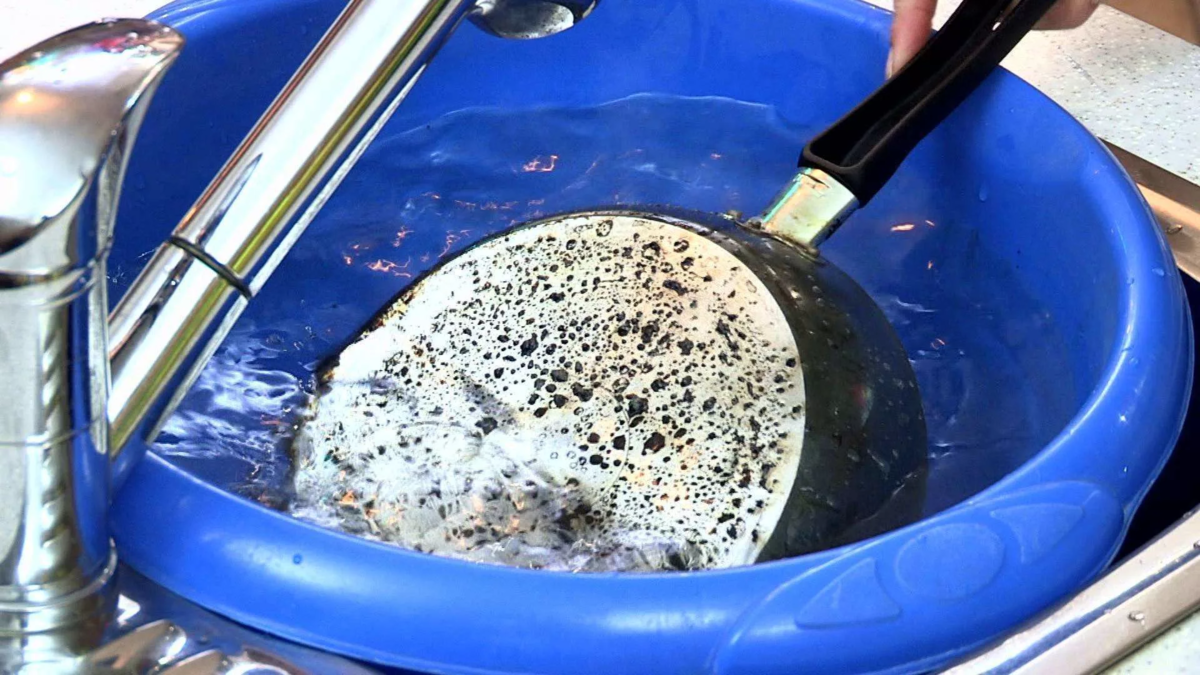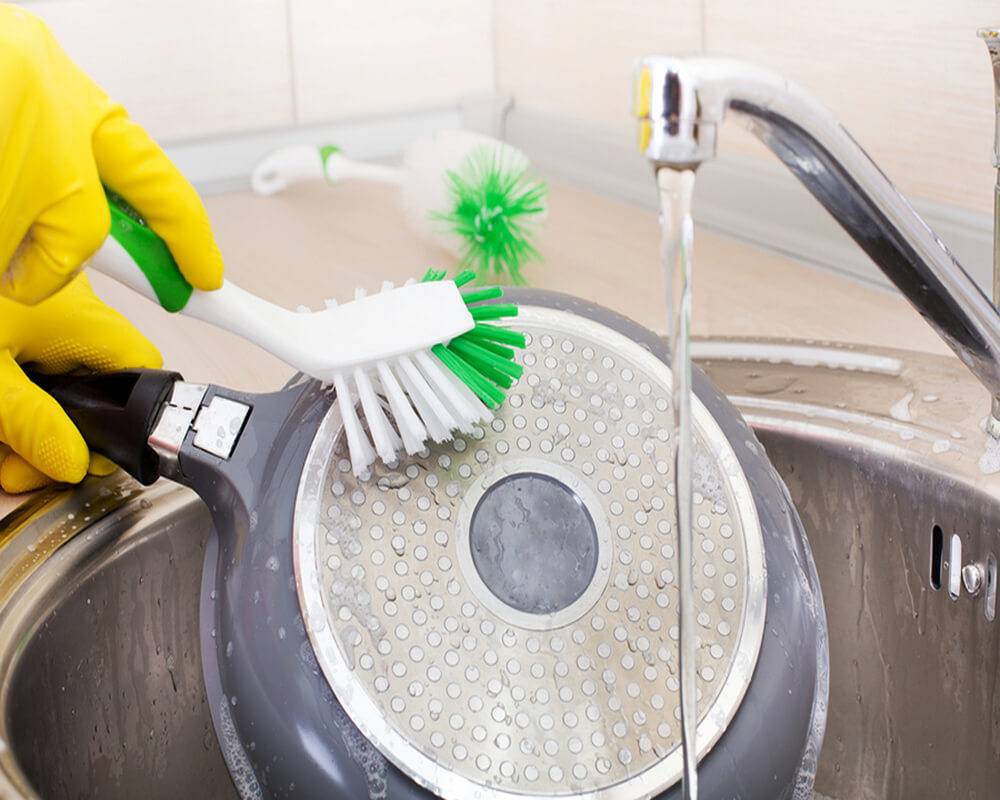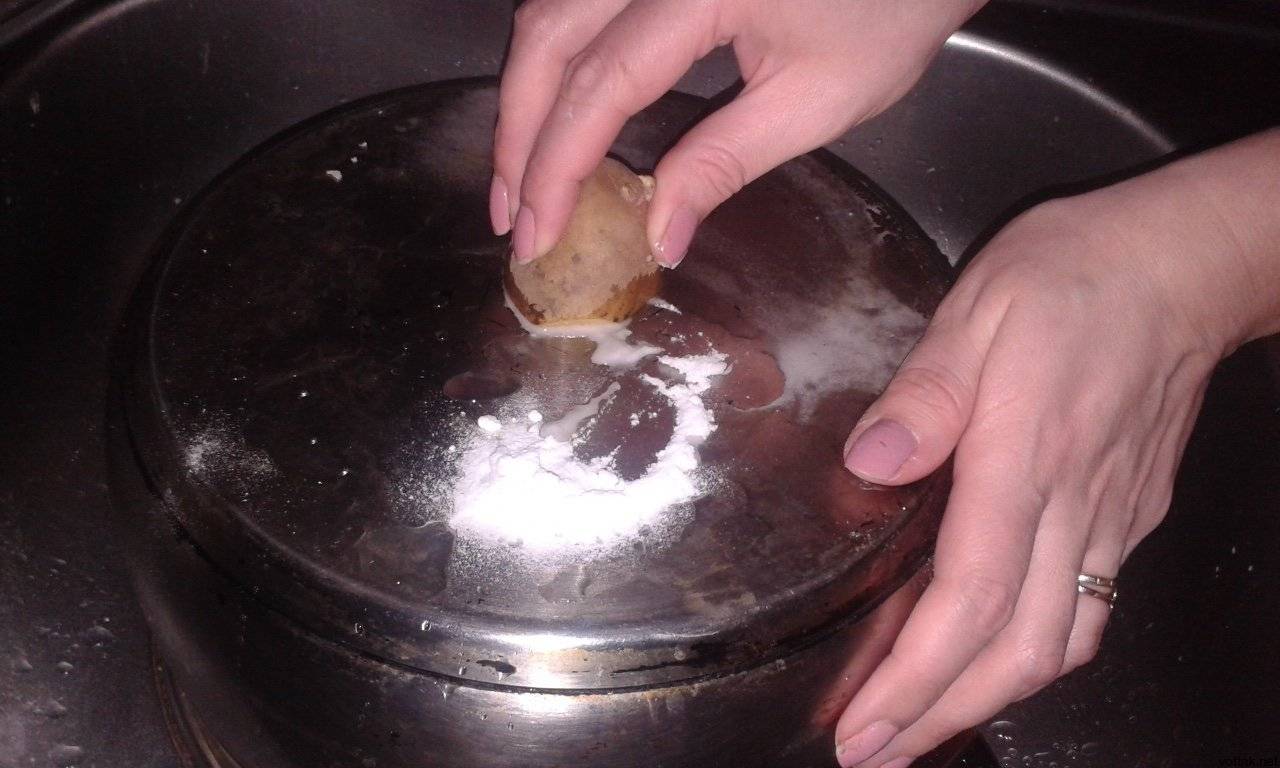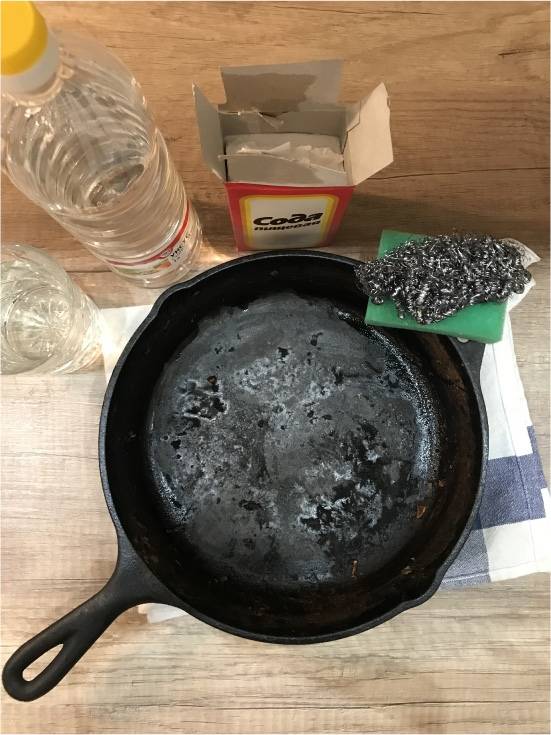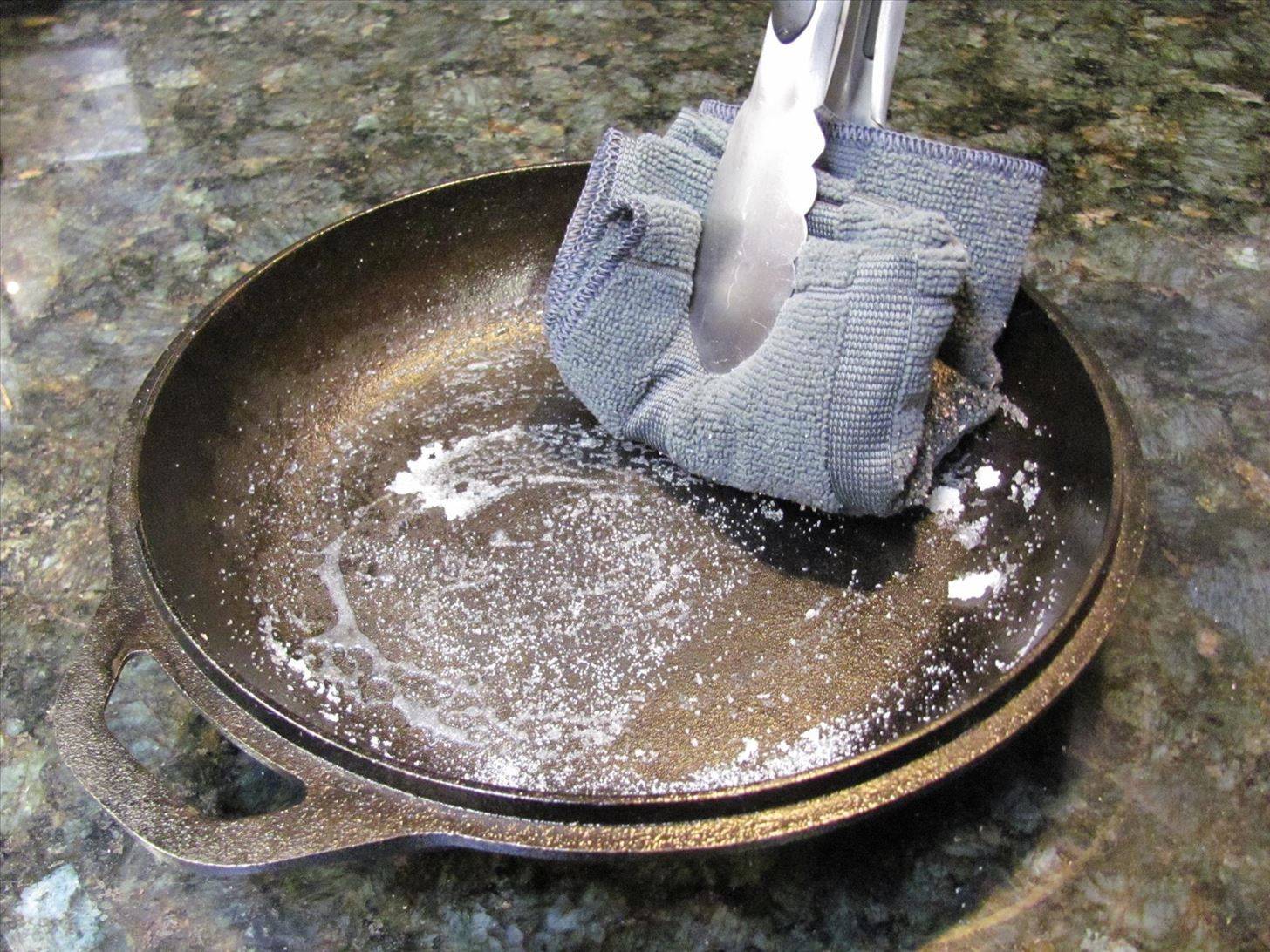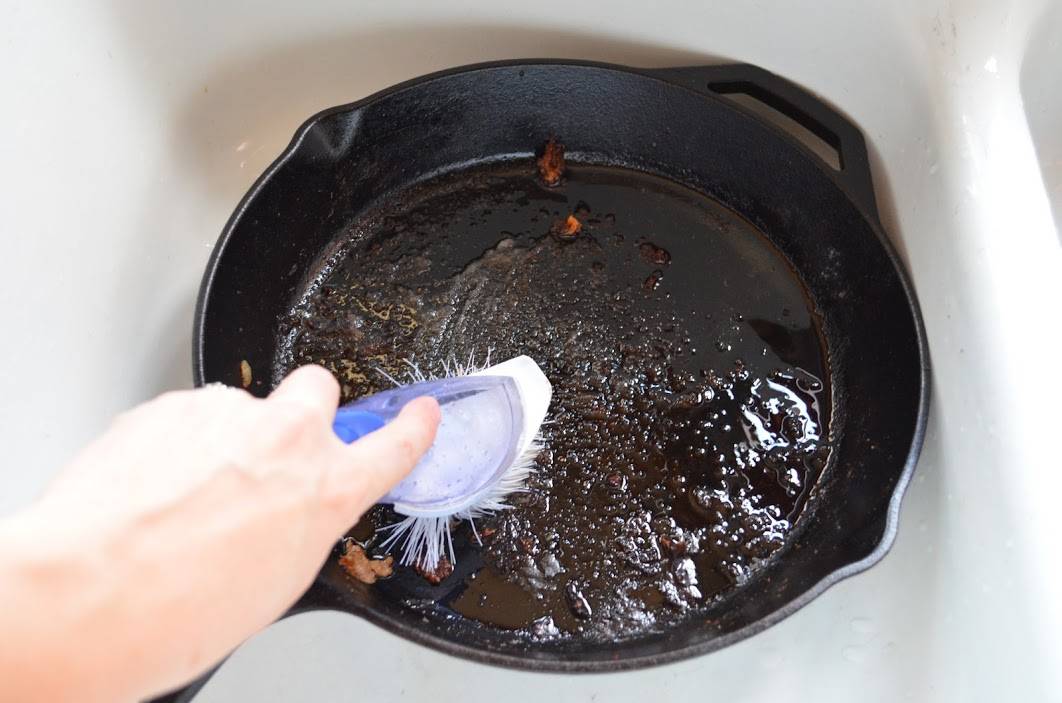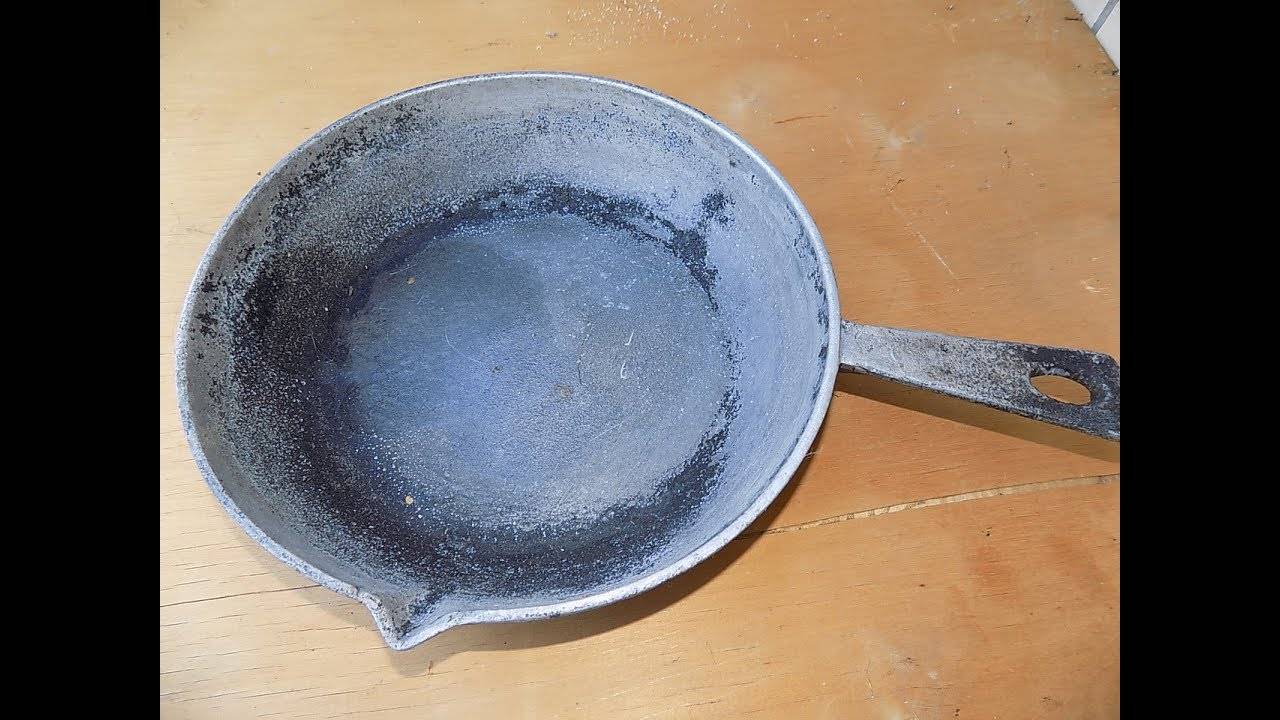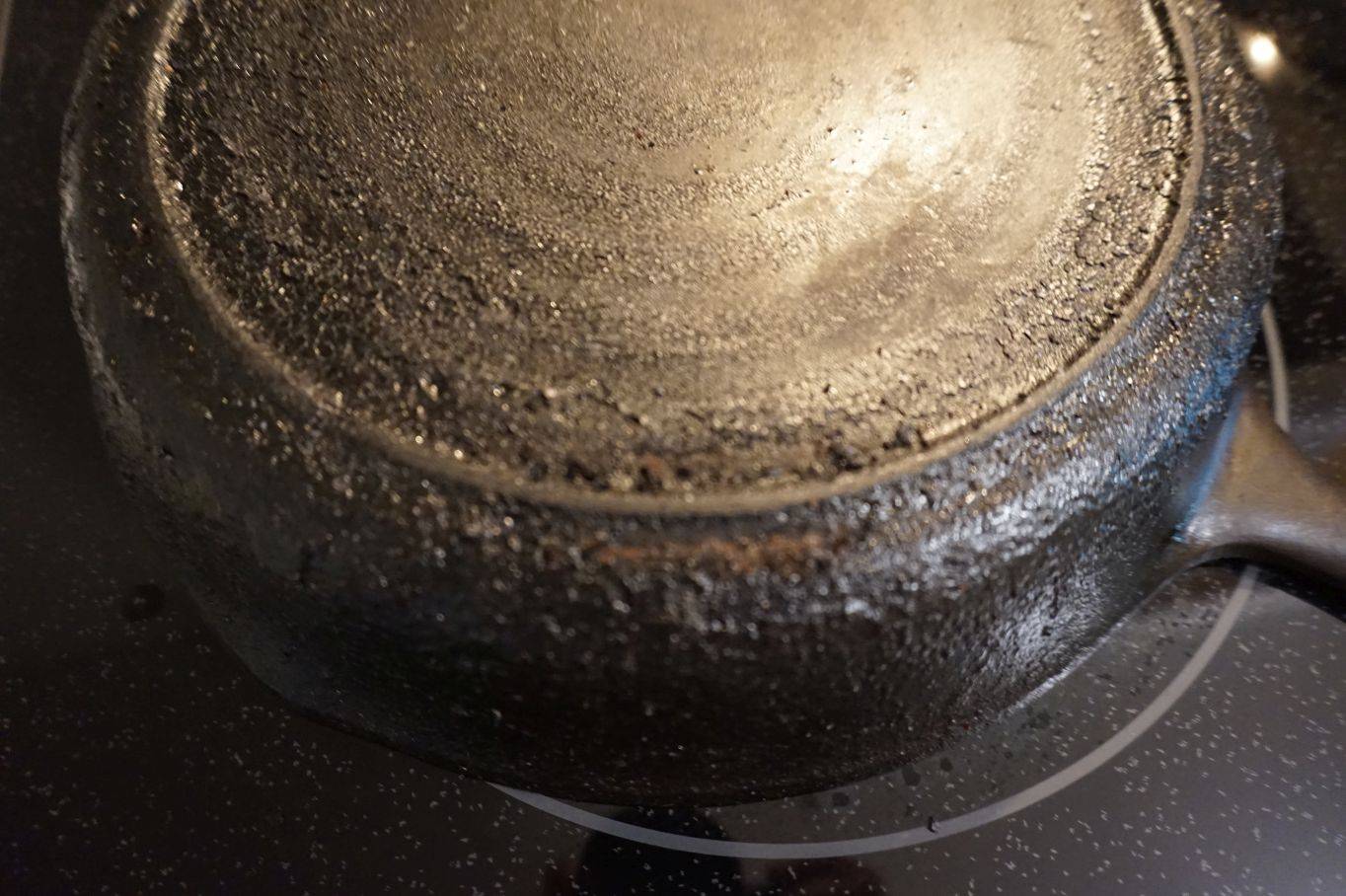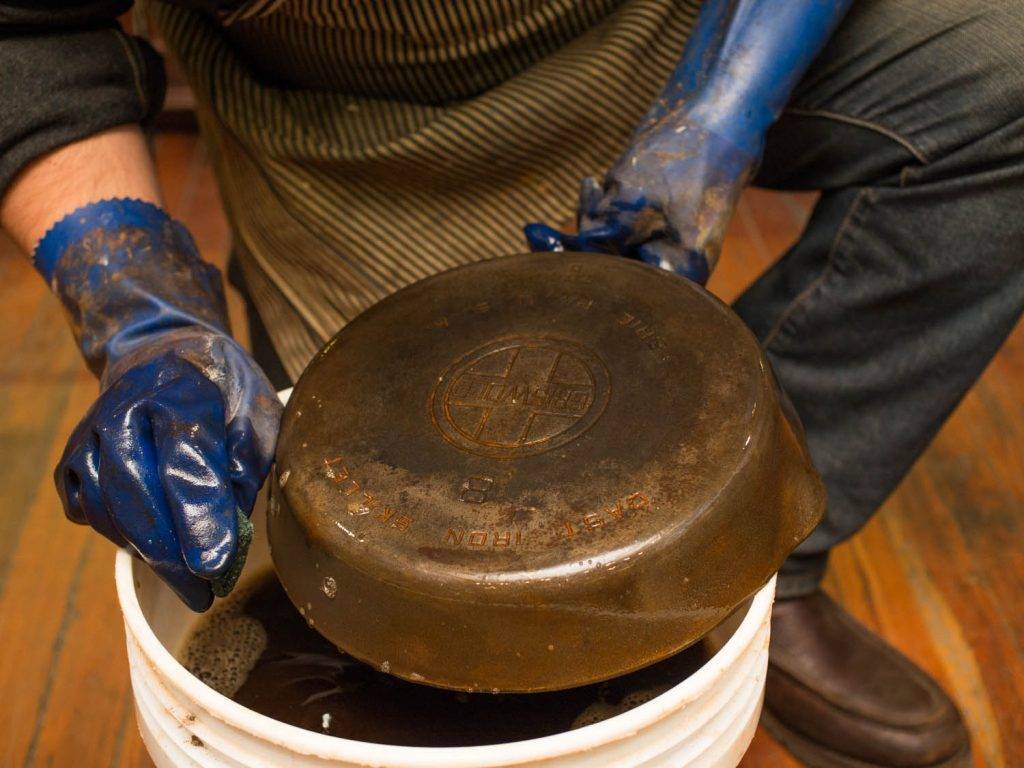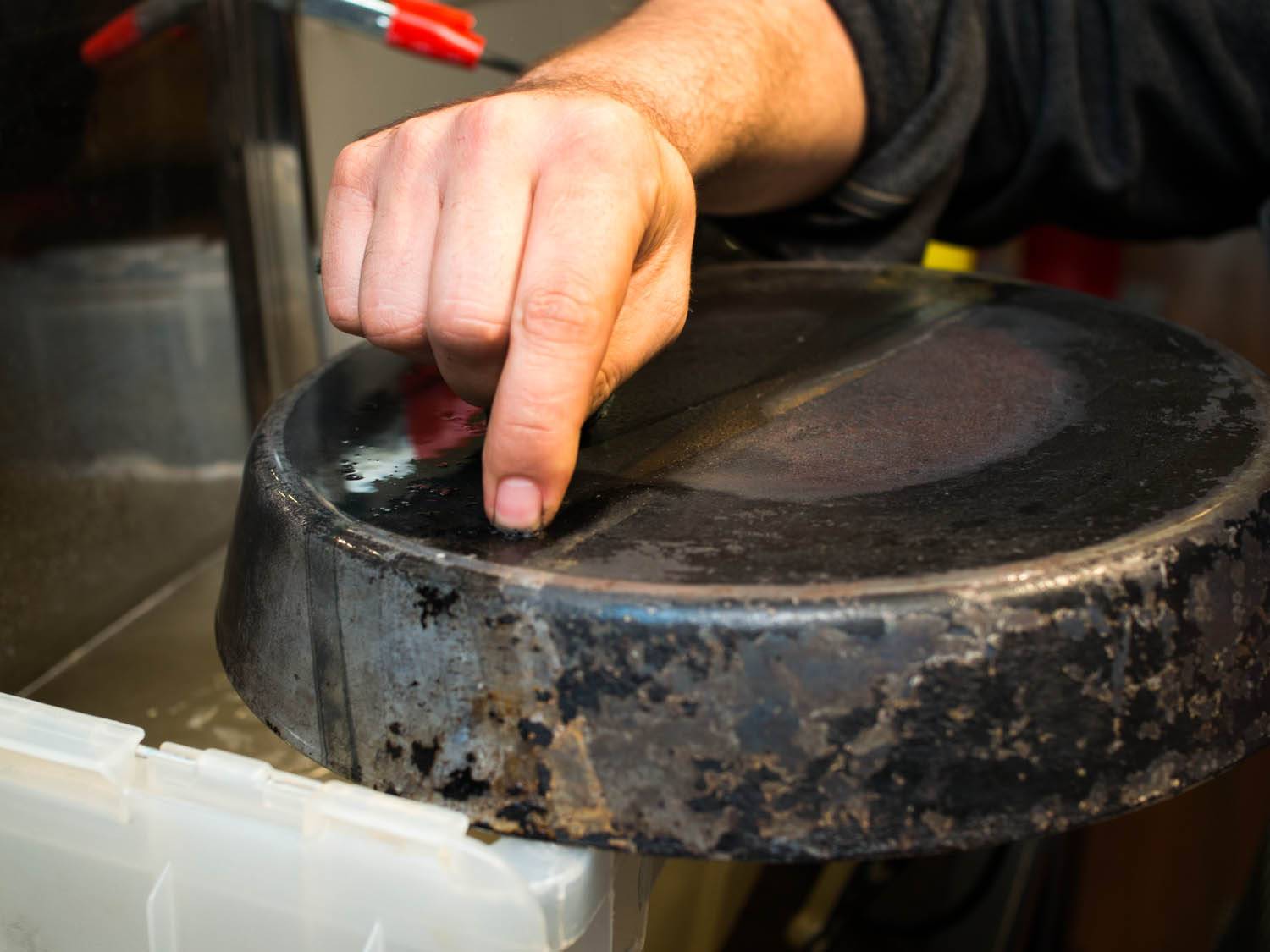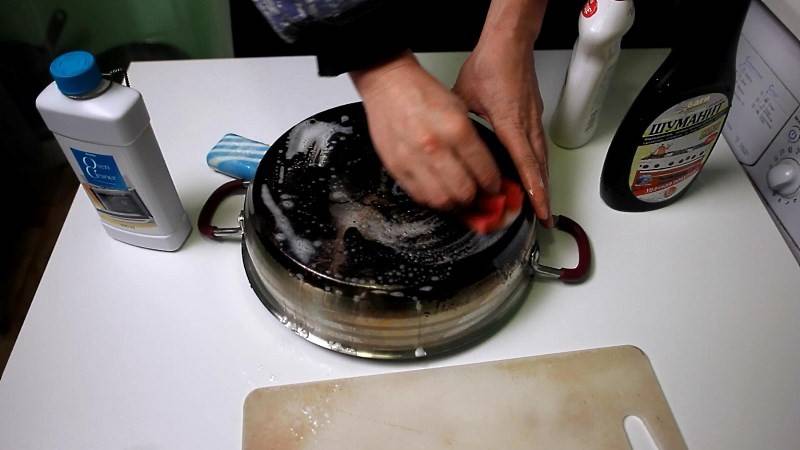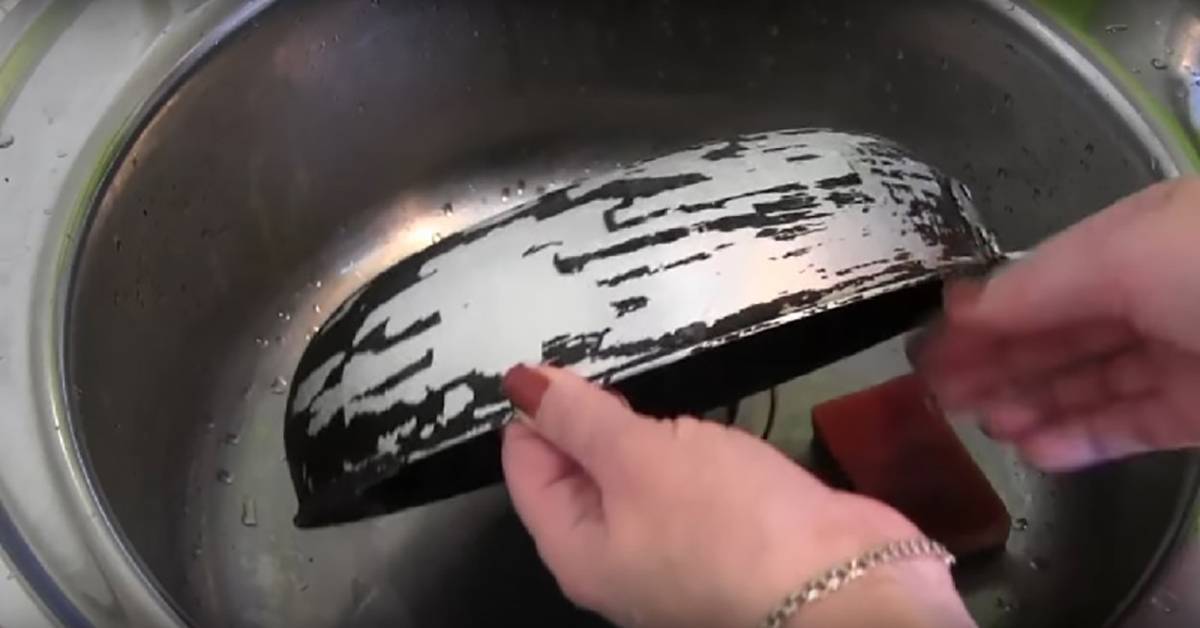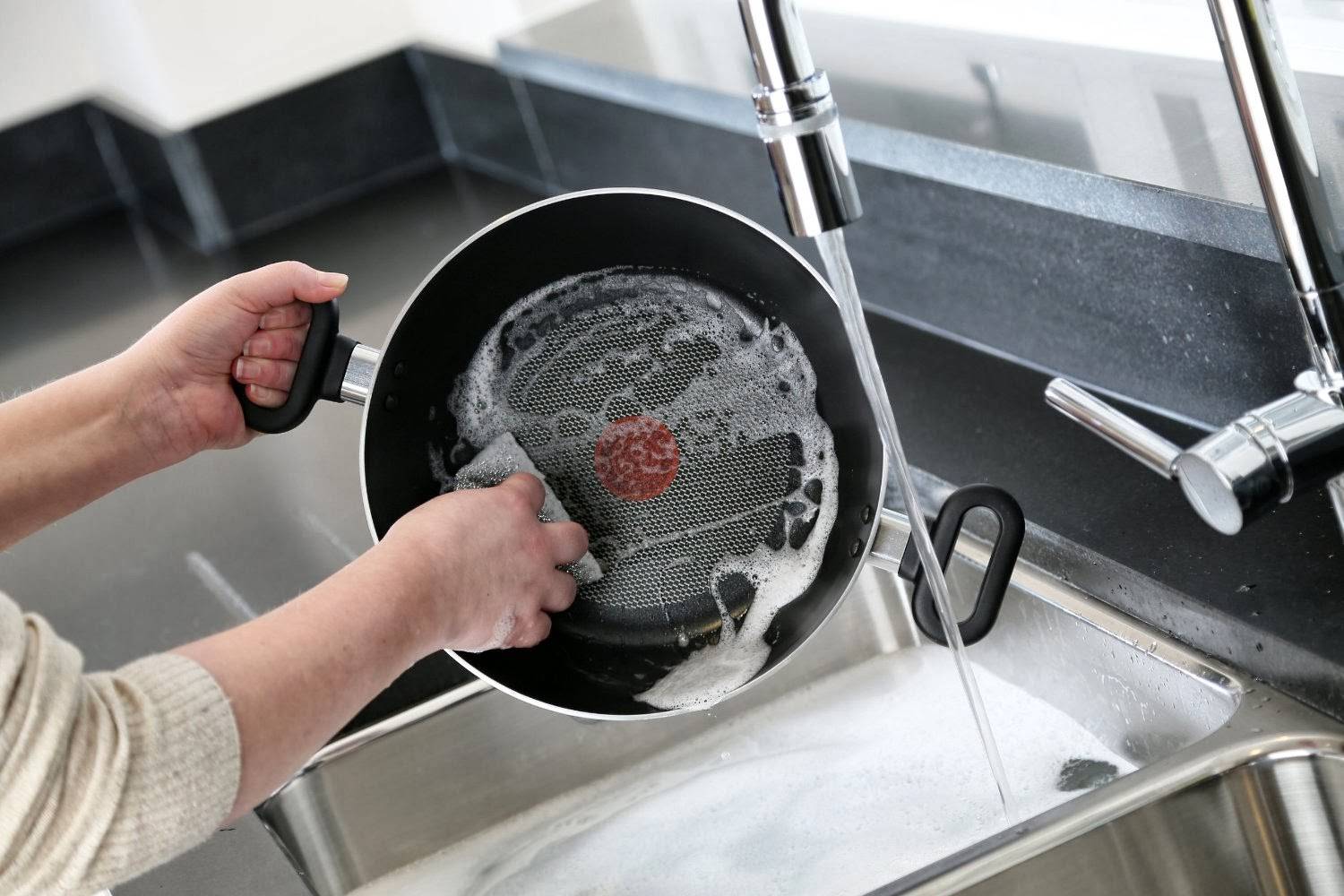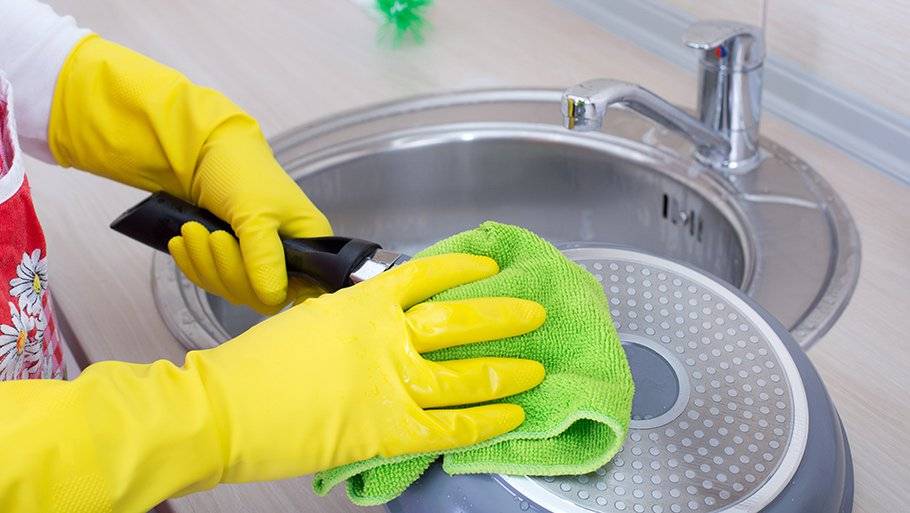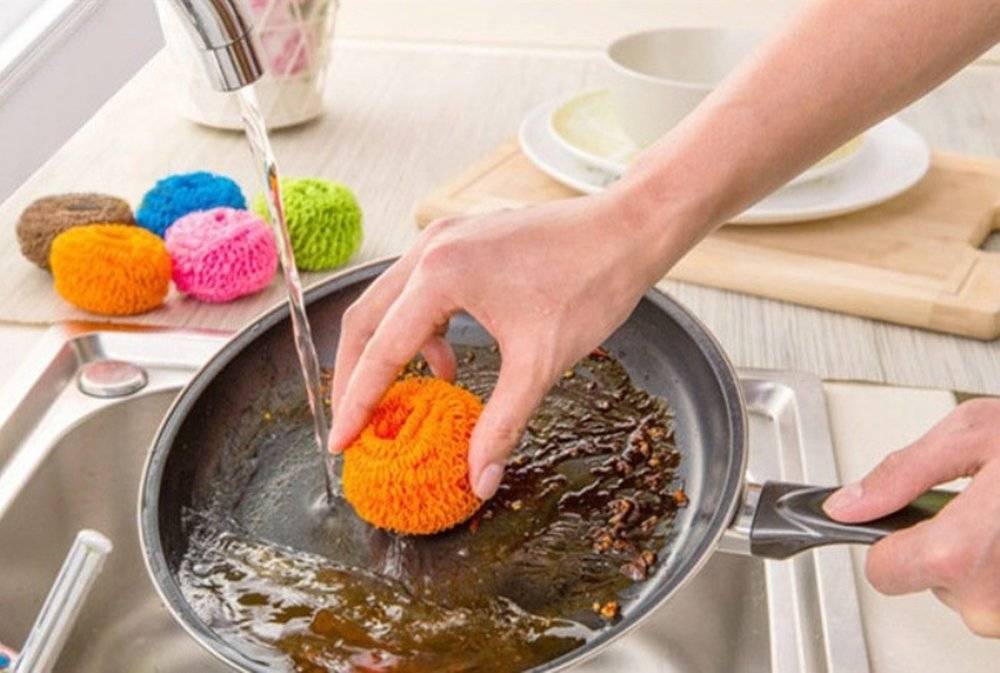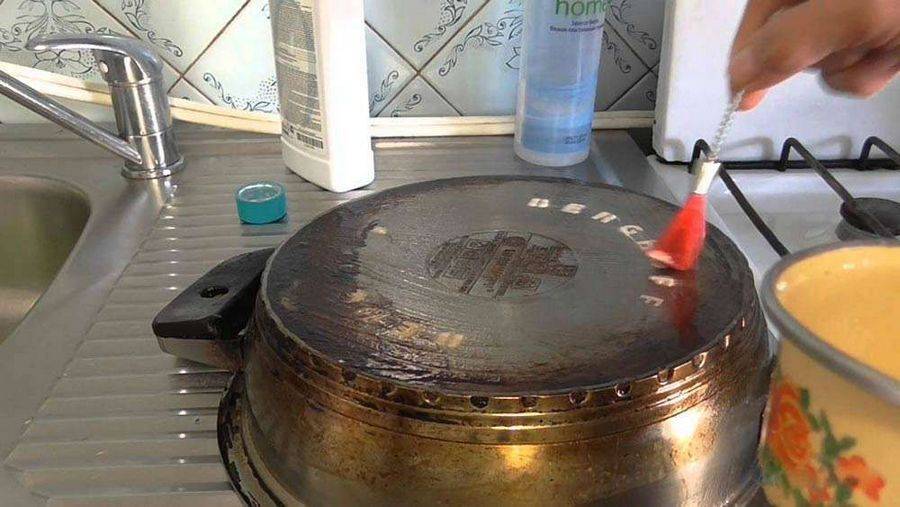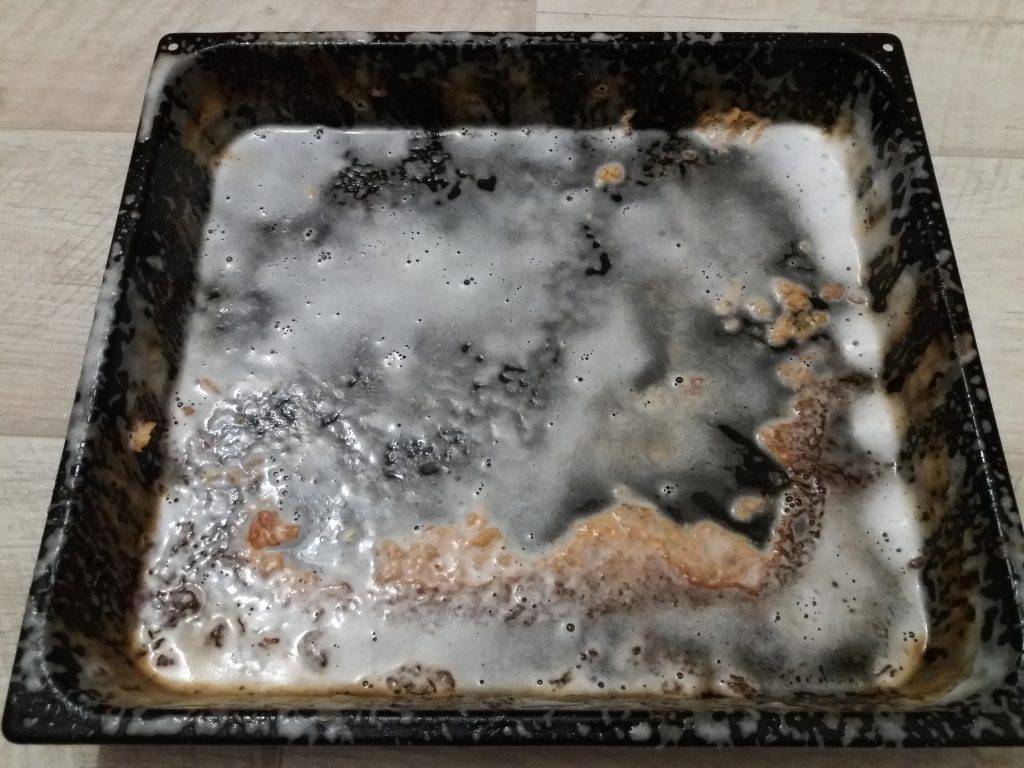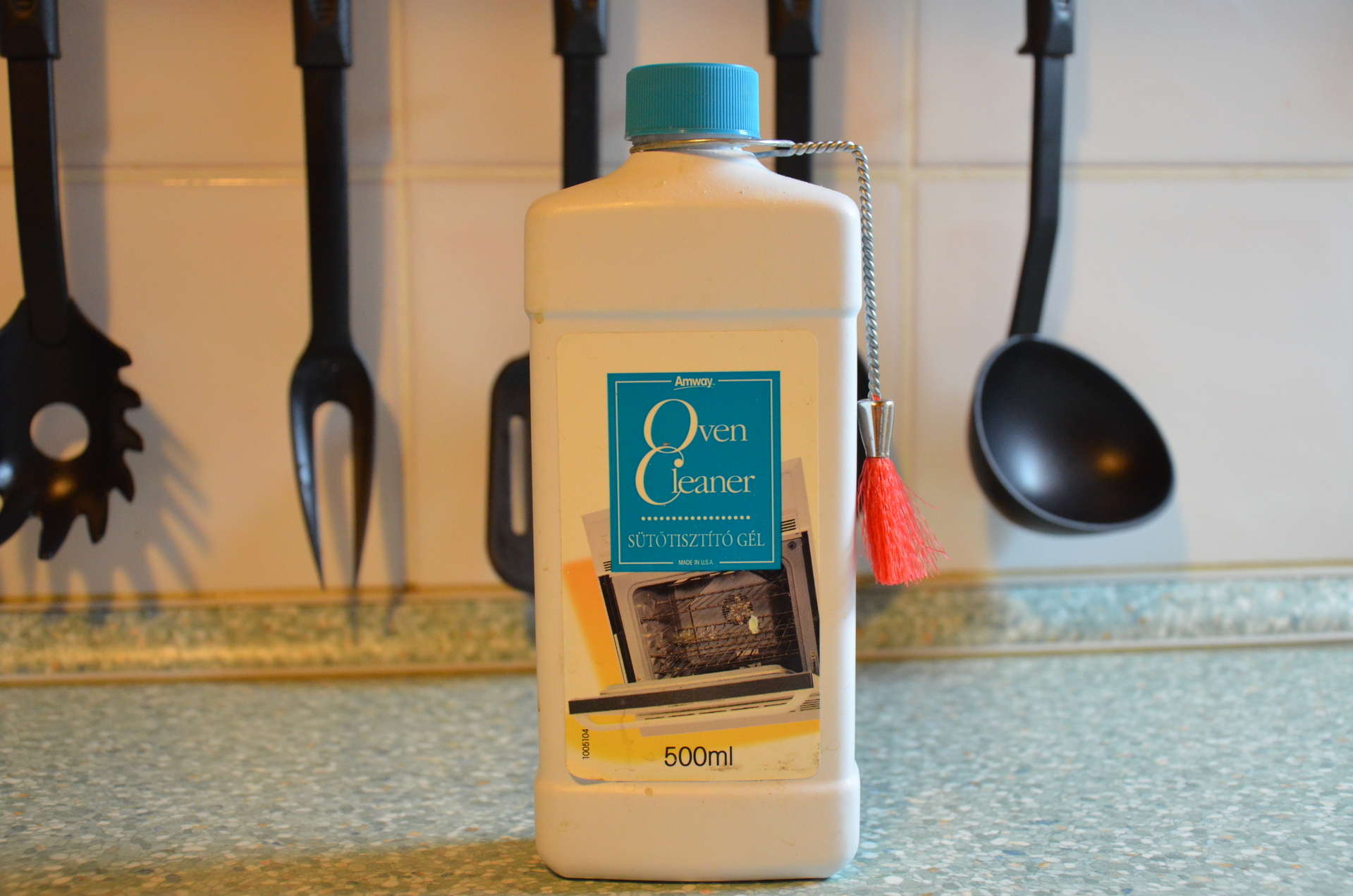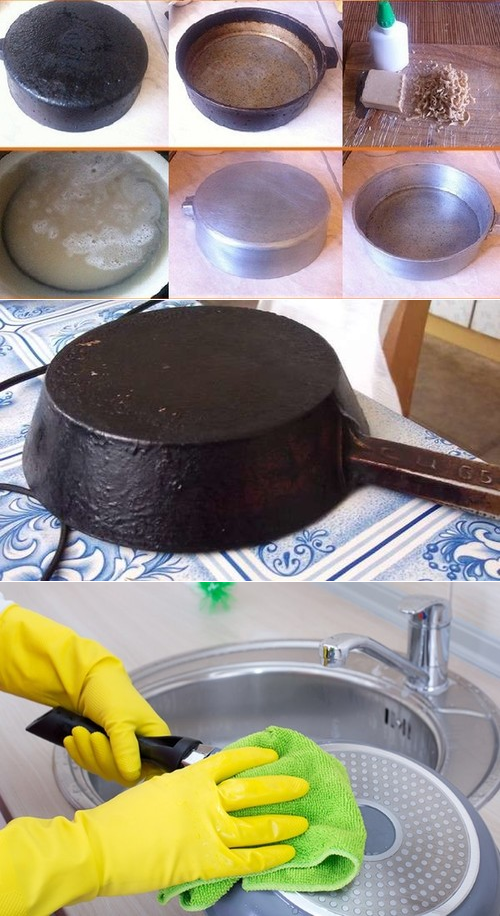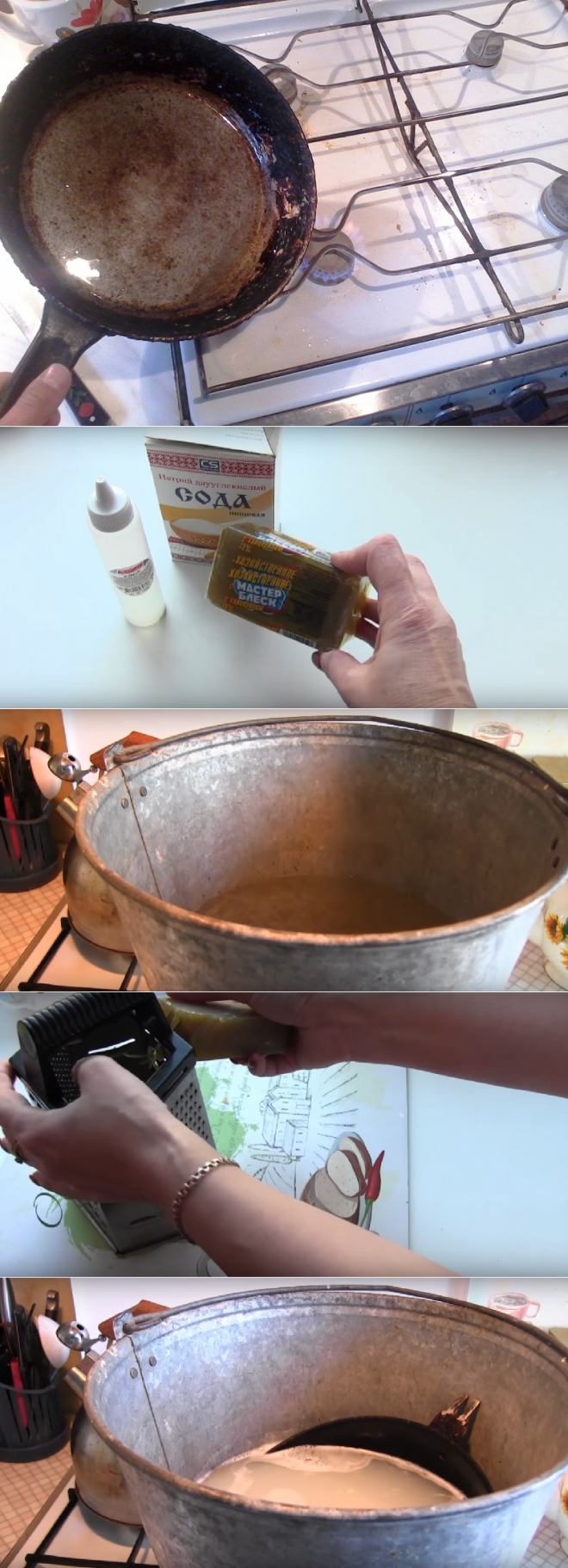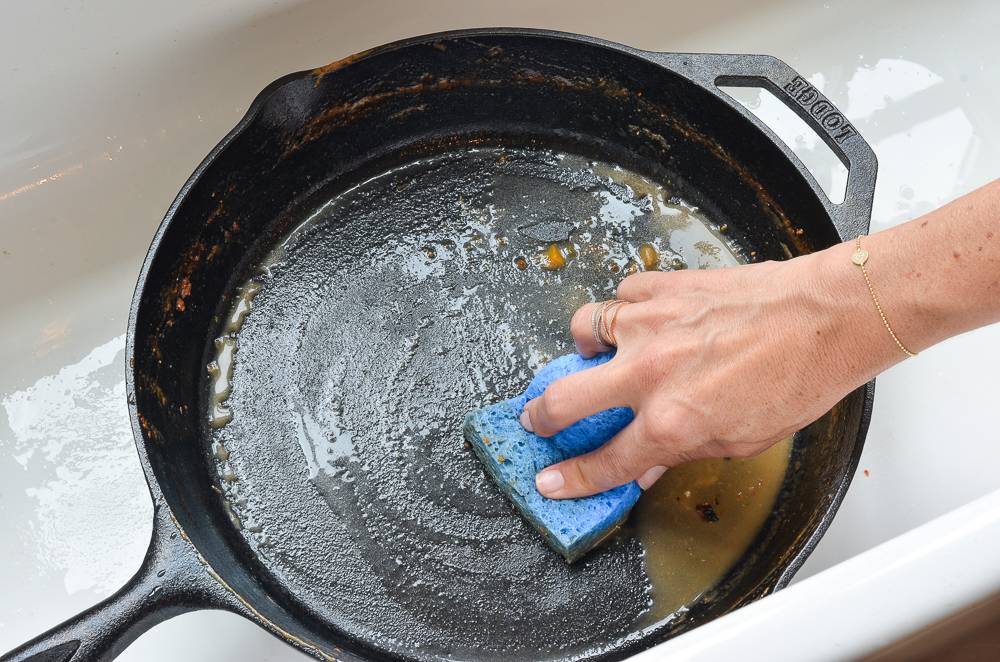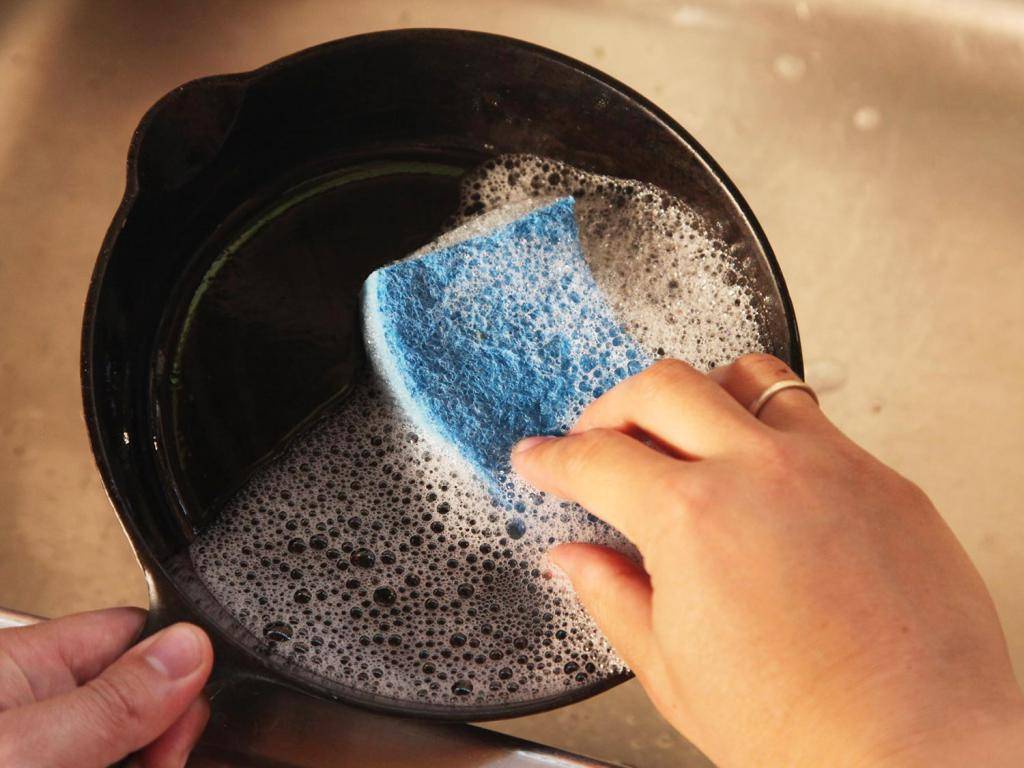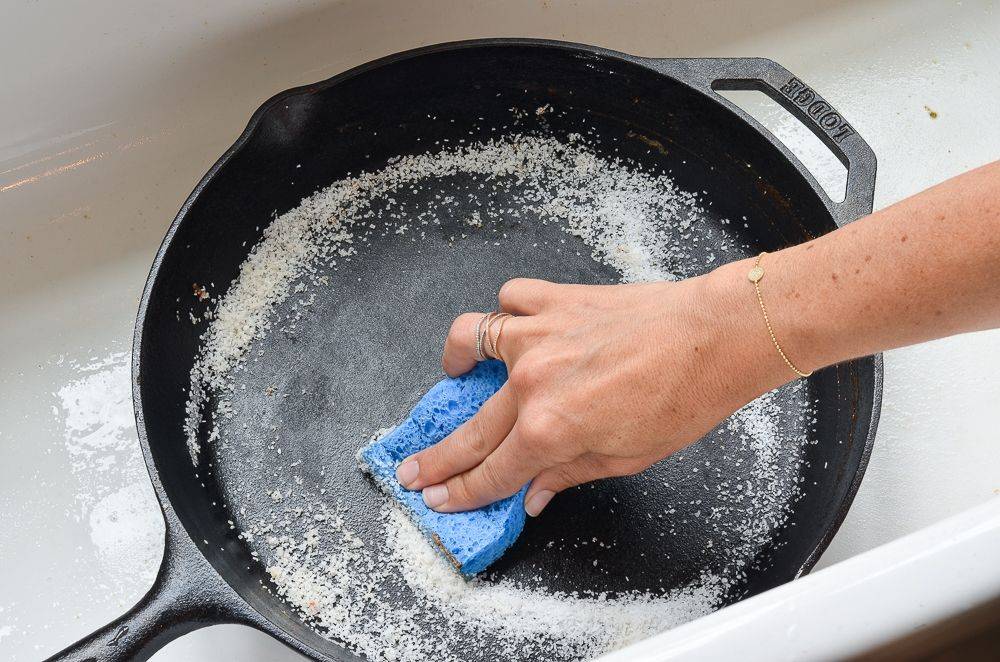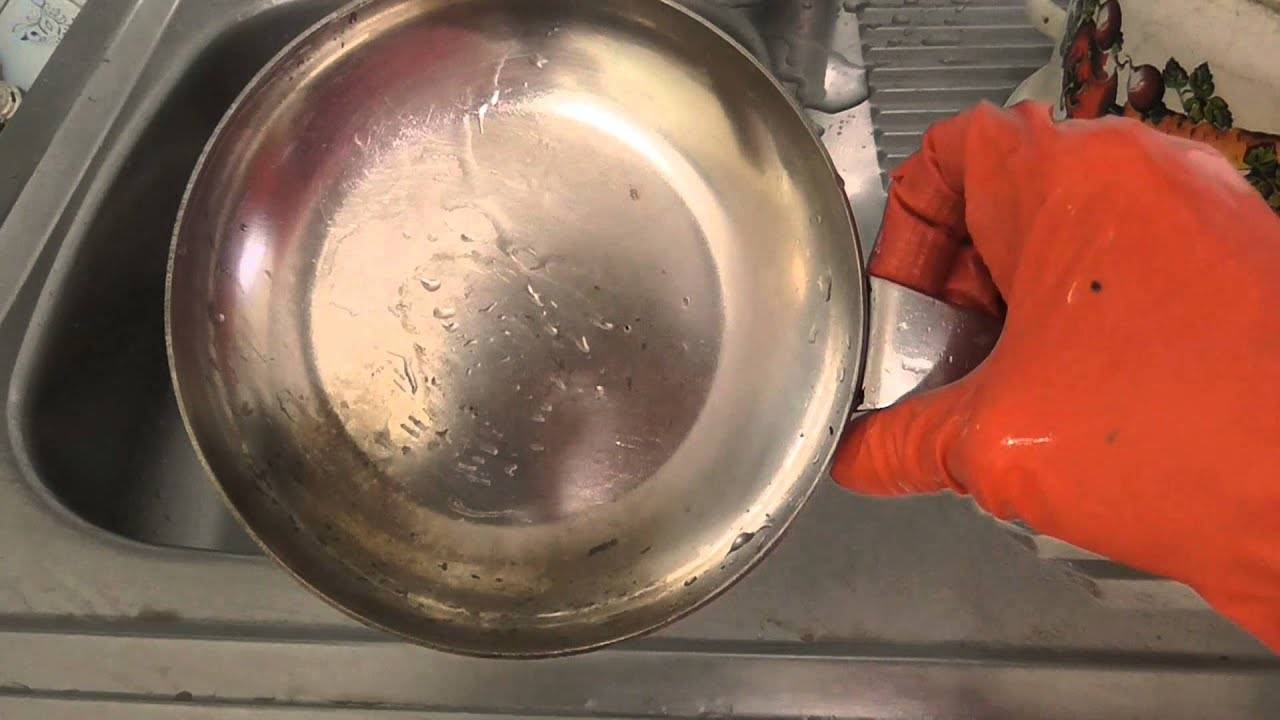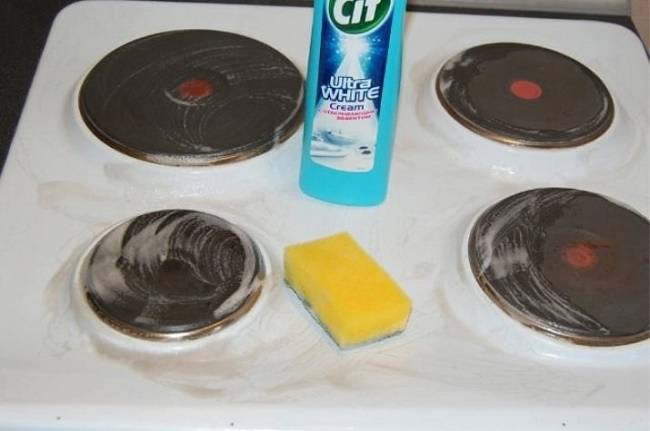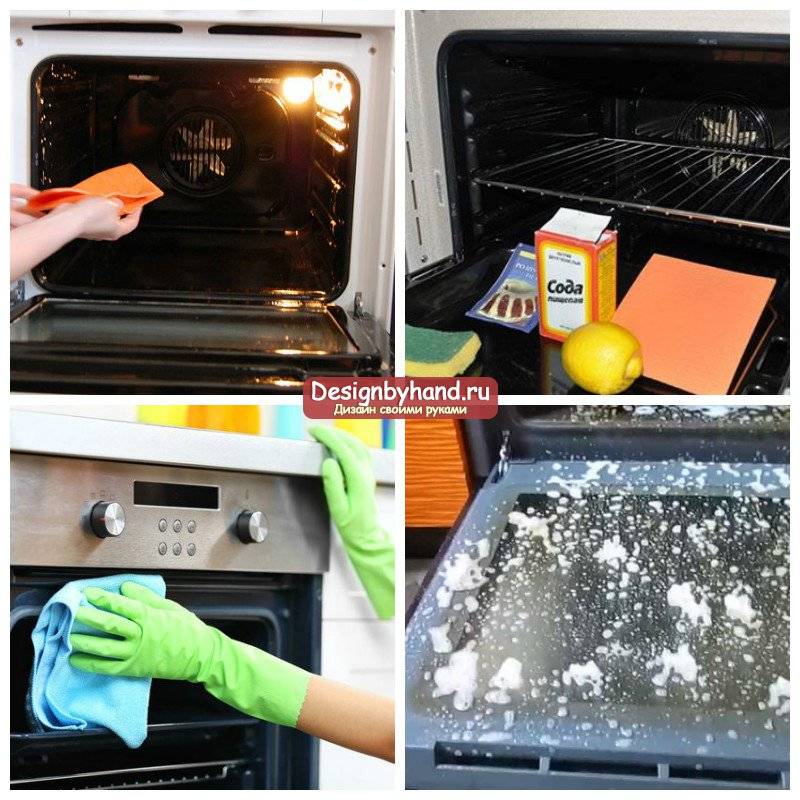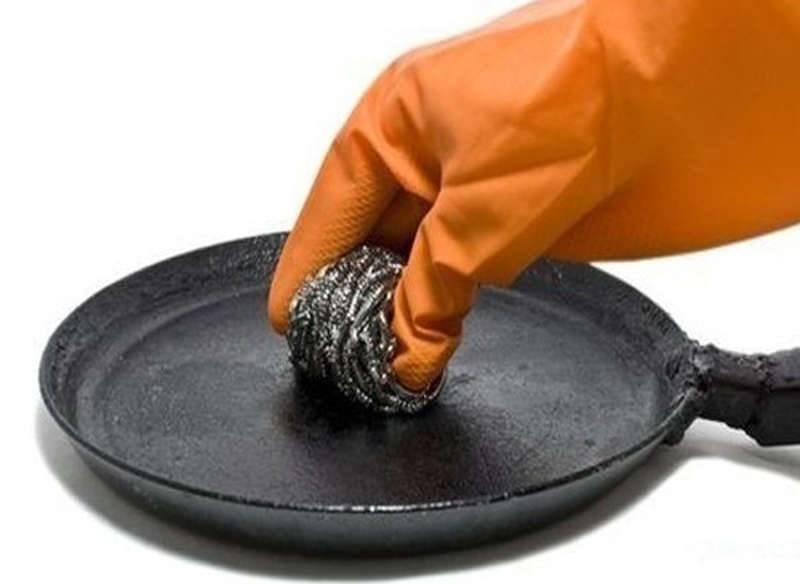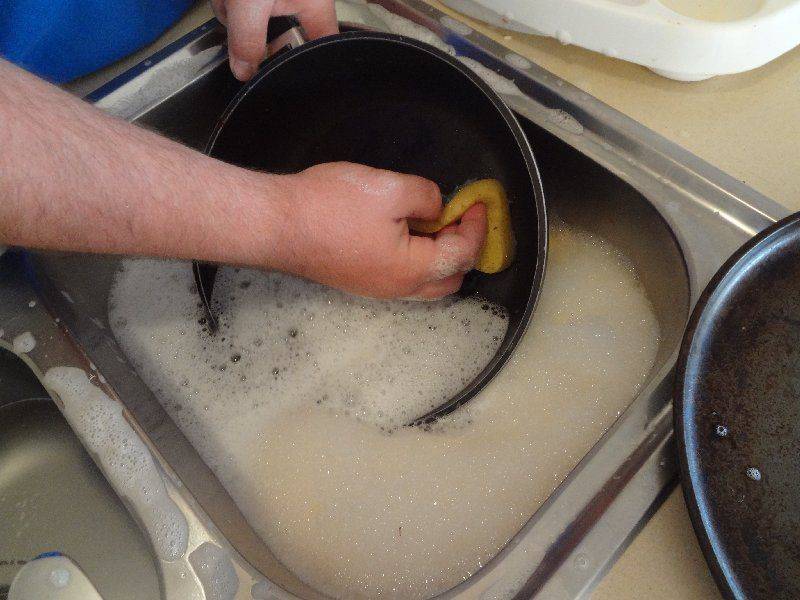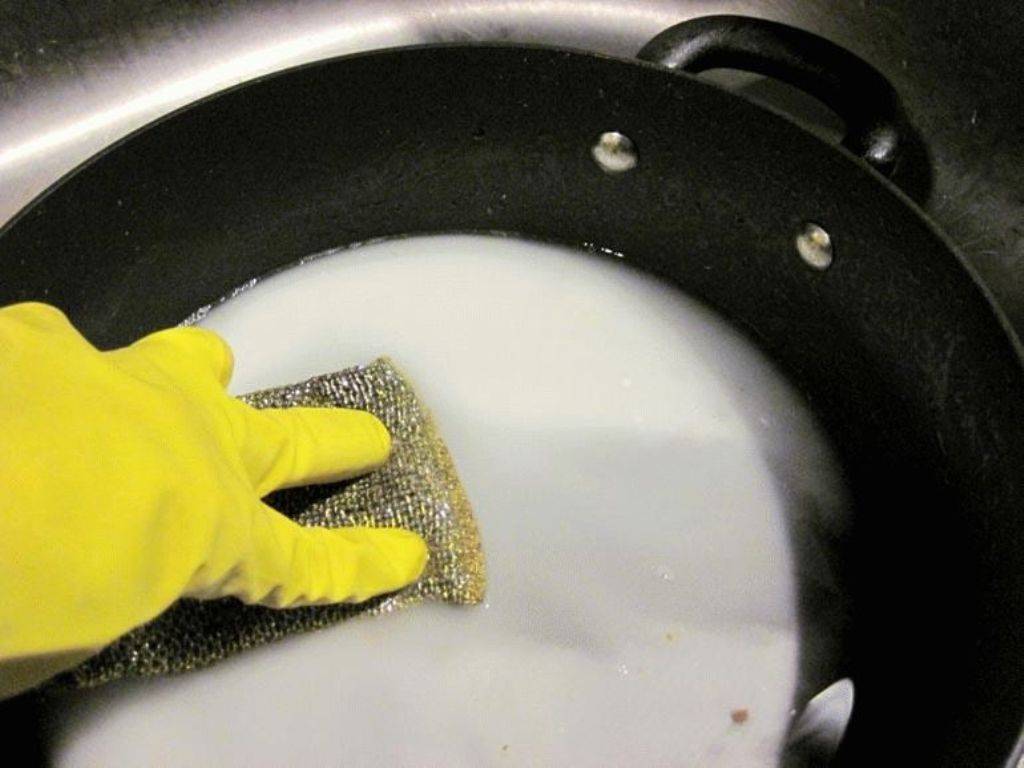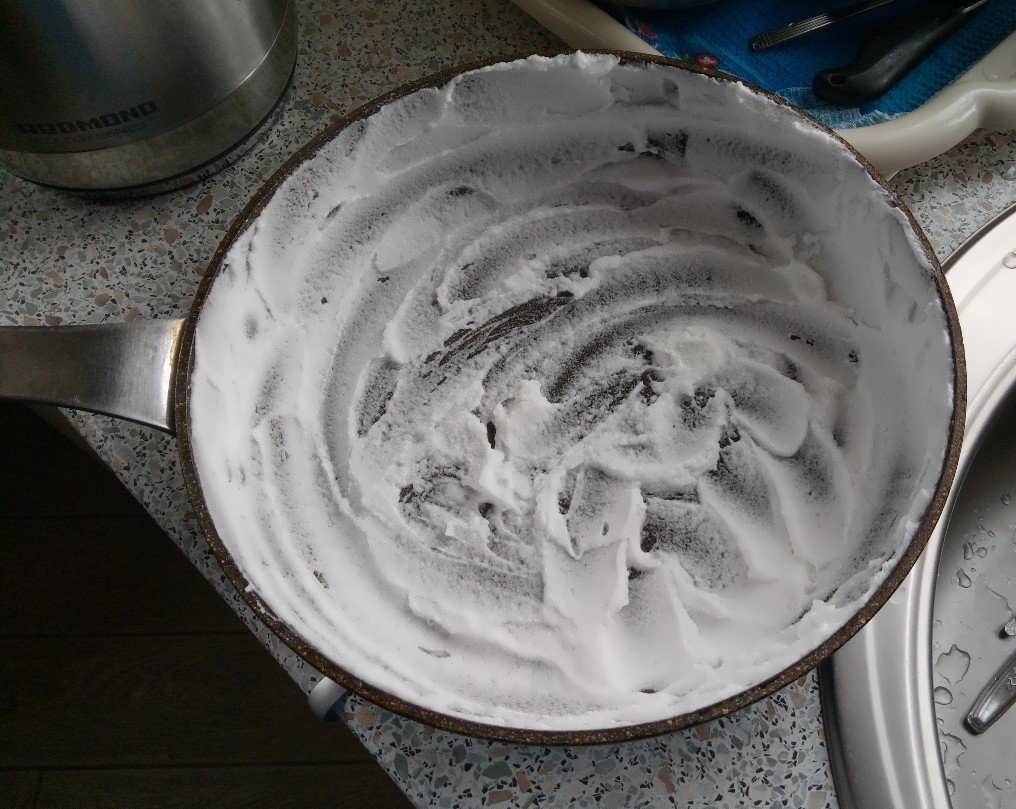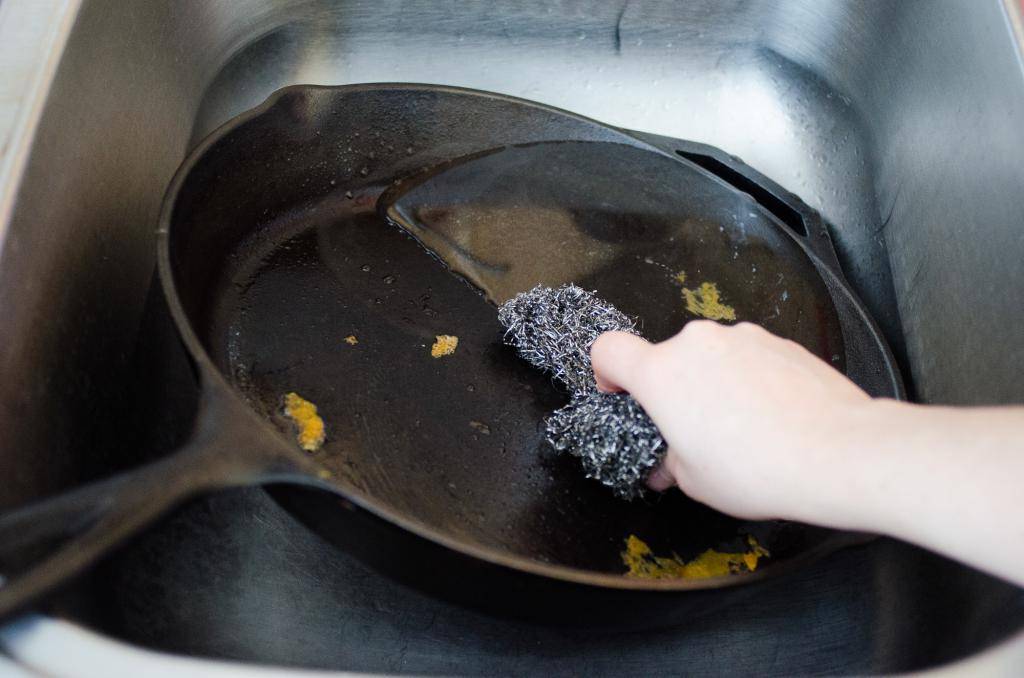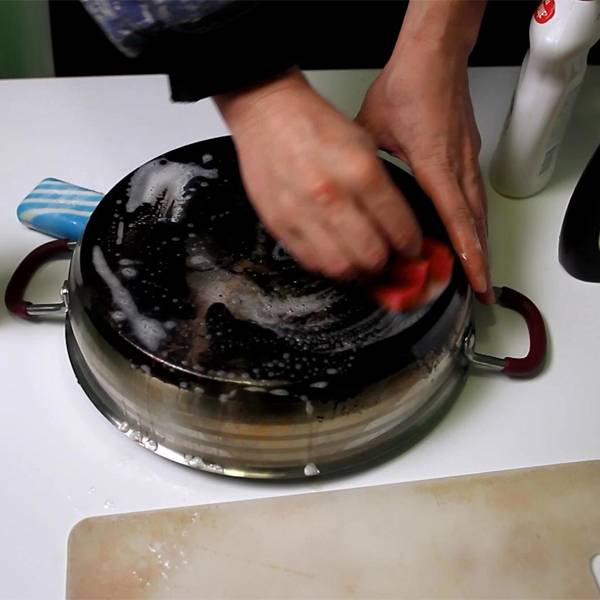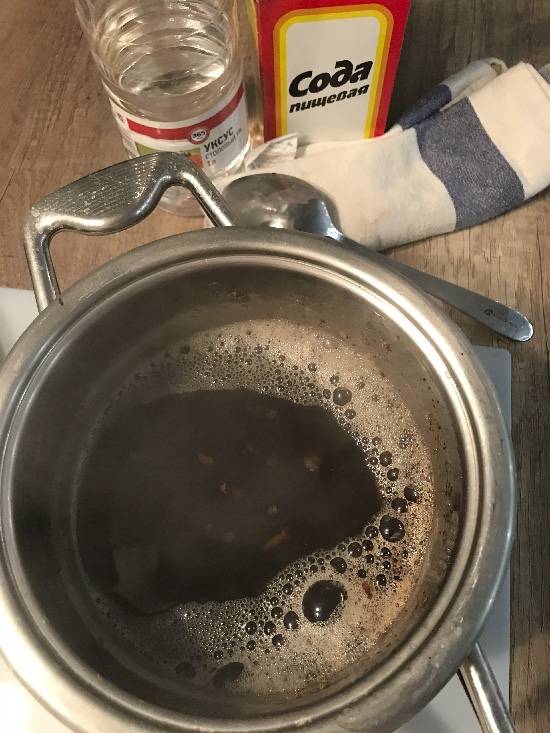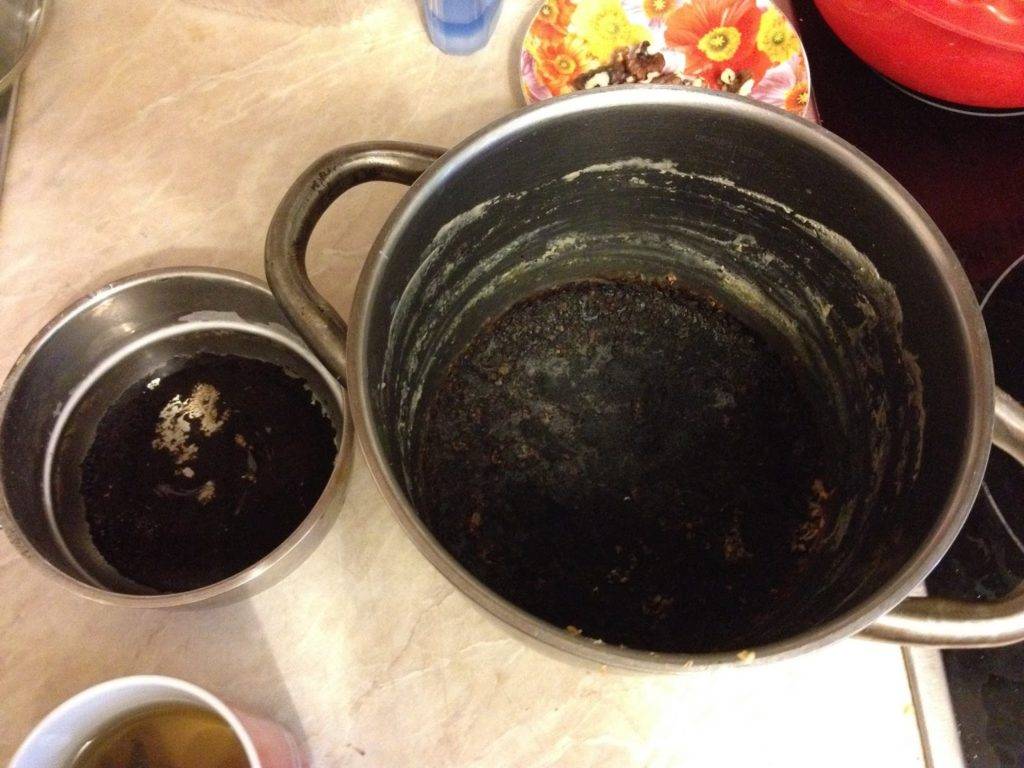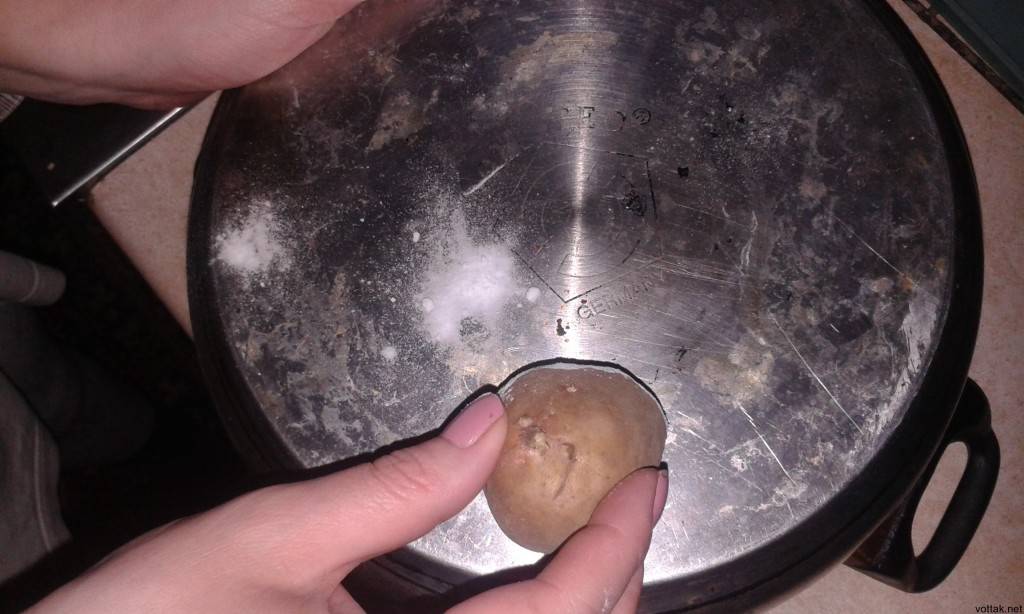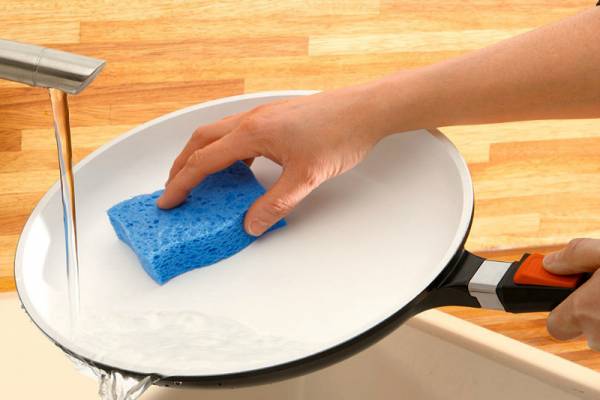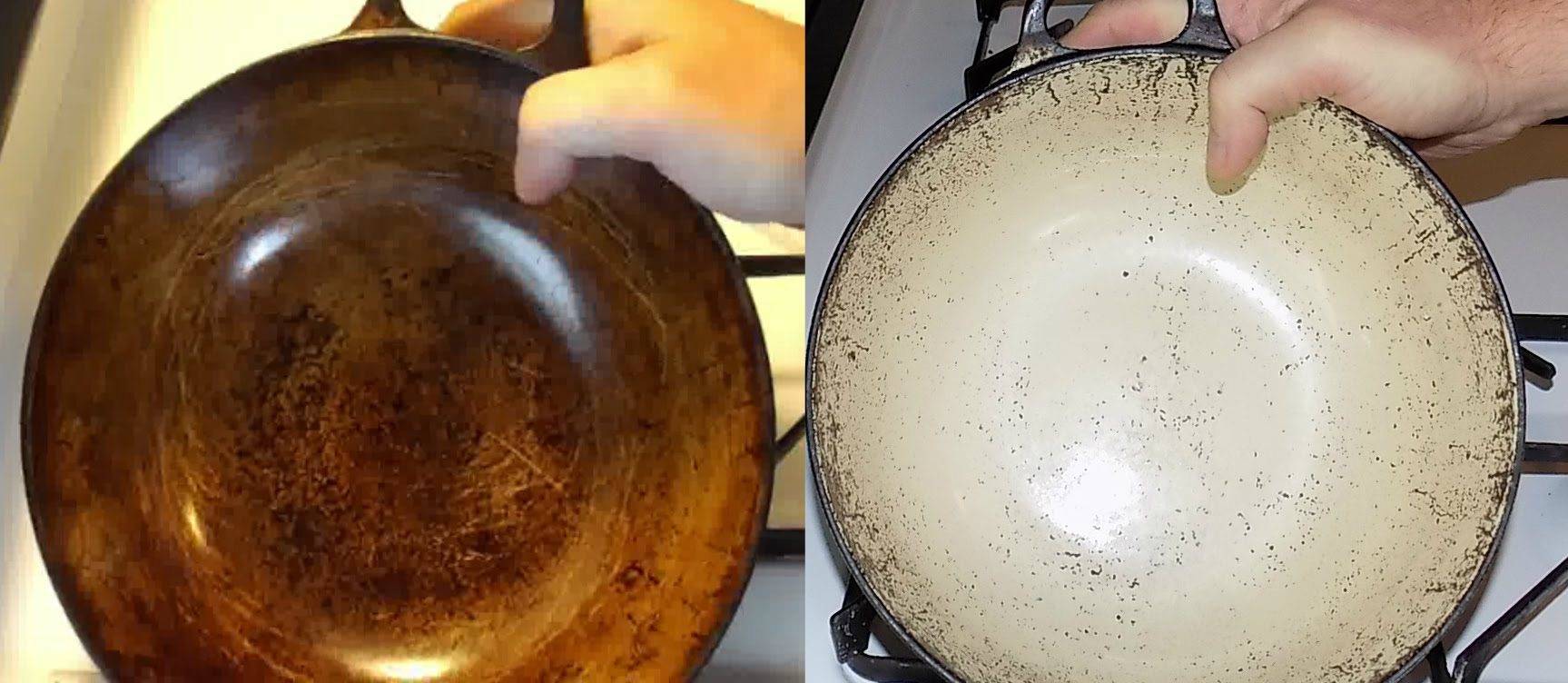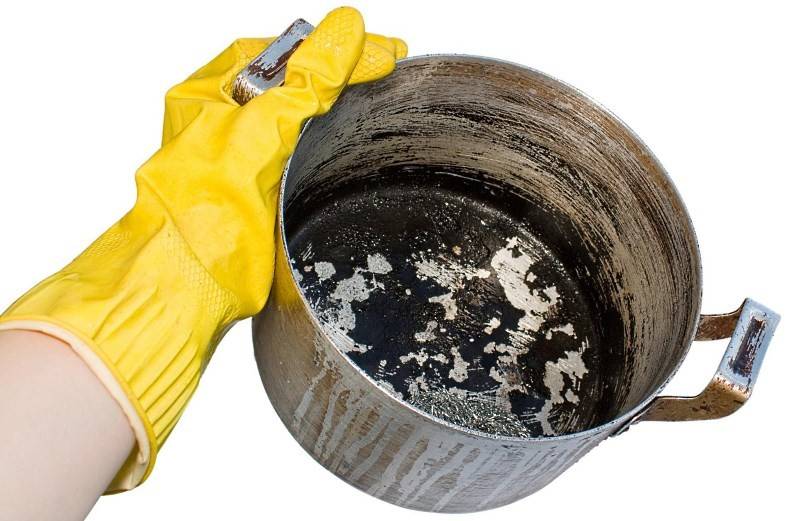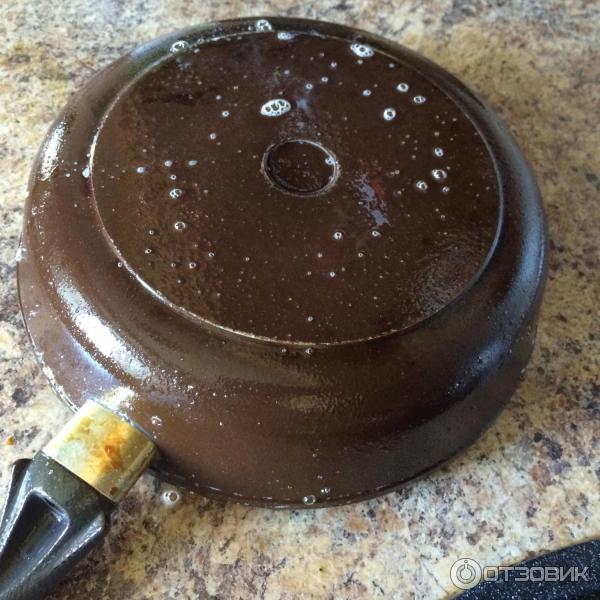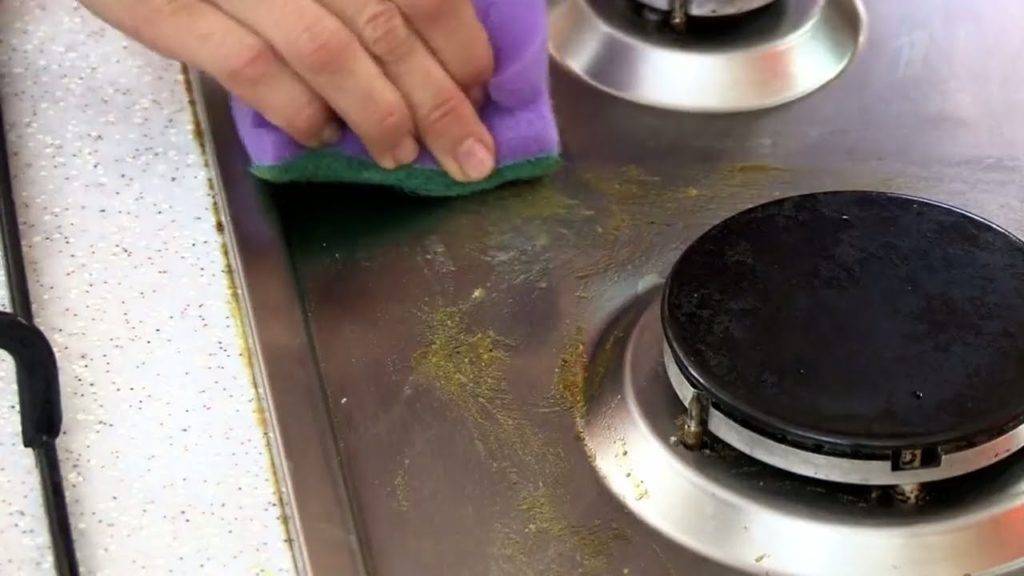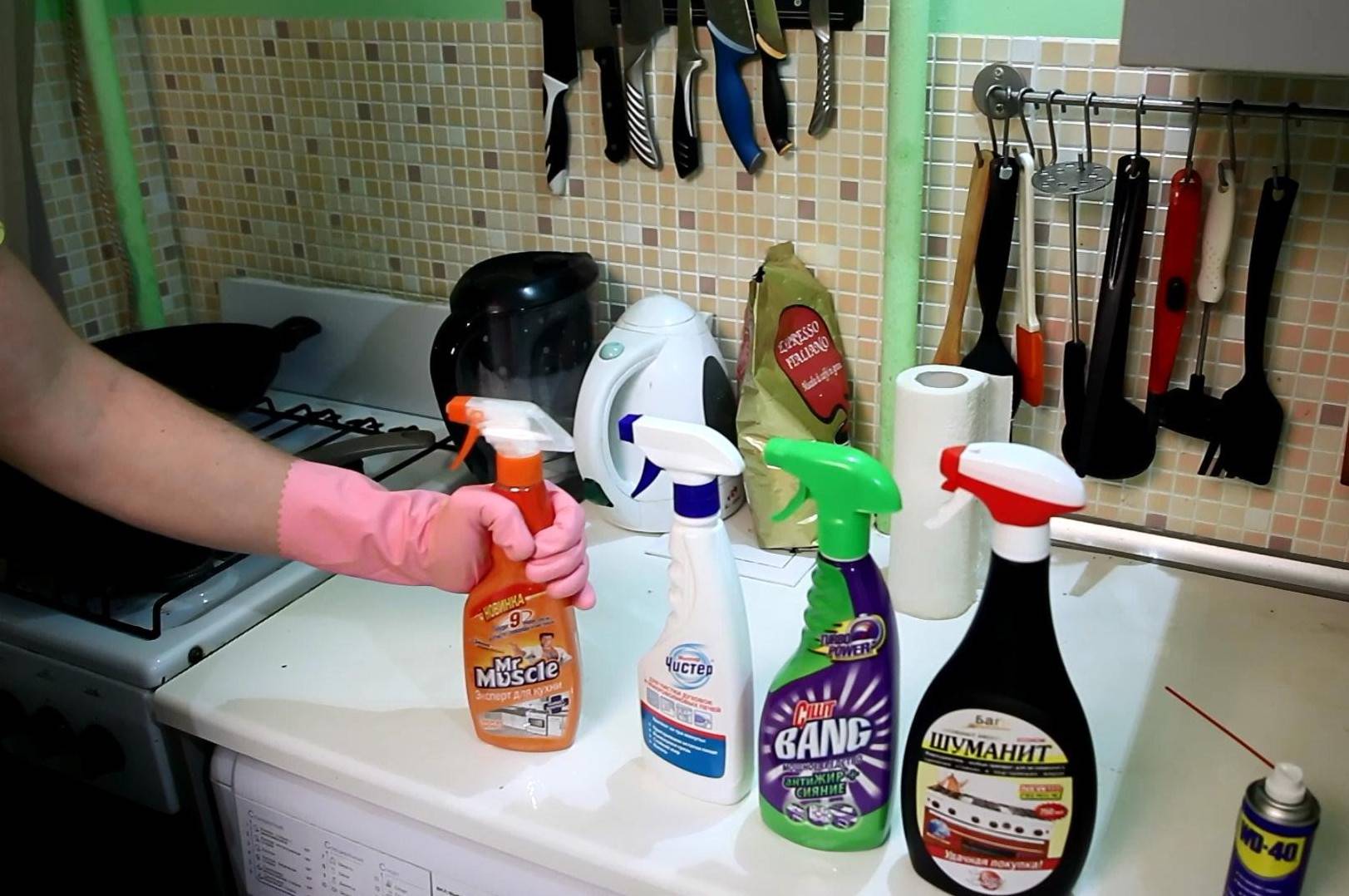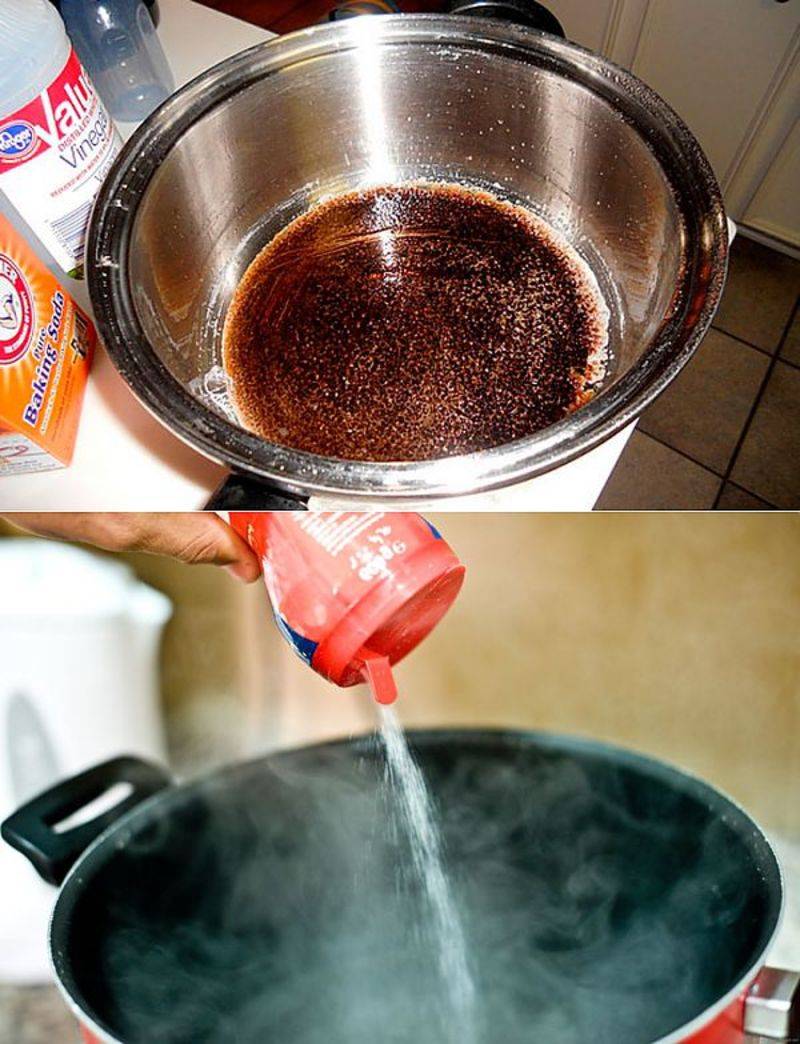How to clean dishes from soot and grease - simple ways
Soaking in water and boiling
The easiest and most affordable way to clean almost all types of dishes made of any material is to soak in water for several hours. Increased water temperature, boiling accelerate the process of "softening" oily deposits. You can, by adding detergent, repeat the procedure several times, washing off layer by layer.
This option will help with fresh or very light dirt. How to remove carbon deposits from an old frying pan? The old layer of fat is unlikely to be removed in this way. Others will do.
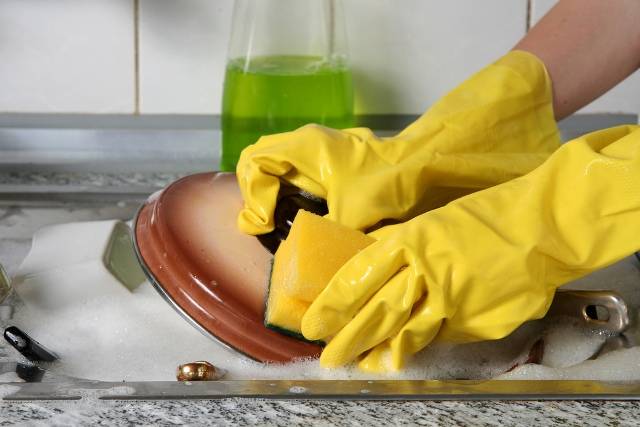
Using salt to clean dishes
To clean the frying pan or other utensils from greasy carbon deposits on the inner surface, use ordinary table salt. The grinding can be any, even large, even small. Pour about half a glass of salt into the pan so that it completely covers the bottom. Moisten slightly with water and leave for several hours. The salt will "eat away" the burnt layer, loosen it and it can be easily washed off with a sponge and water.
The saline water solution can be boiled in a skillet or saucepan to speed up the reaction.
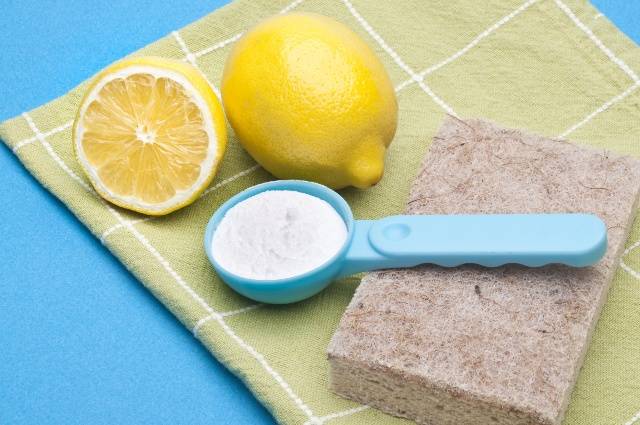
Activated carbon
How to clean dishes from grease if salt baths did not help? Try activated charcoal. Crush it on the bottom of a frying pan or saucepan, you can crush a standard package of tablets in a mortar. Pour in some warm clean water and leave it alone for a quarter of an hour. Such a surface-friendly product will cope with small greasy stains. After removing any charcoal residues, rinse the dishes with detergent and rinse thoroughly.
This option is used to remove burnt milk from the bottom of the pan.
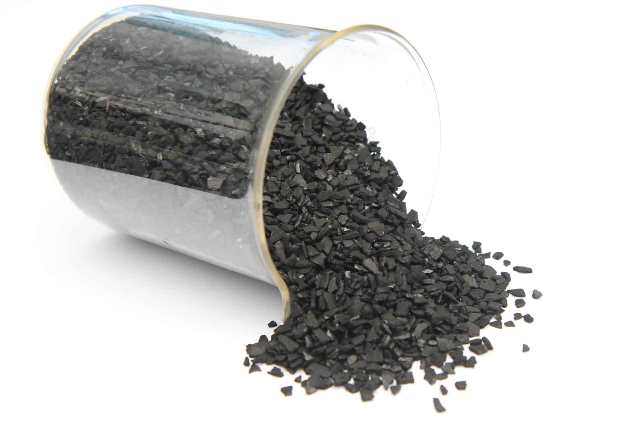
Salt with added vinegar
Add vinegar essence to help with the saline solution. A double blow to the scale should fix the problem in a few hours. If the apartment is well ventilated, the hood is working, then the vinegar-salt solution can be slightly heated. Be careful to wear gloves and a respirator before removing carbon deposits from the pan.
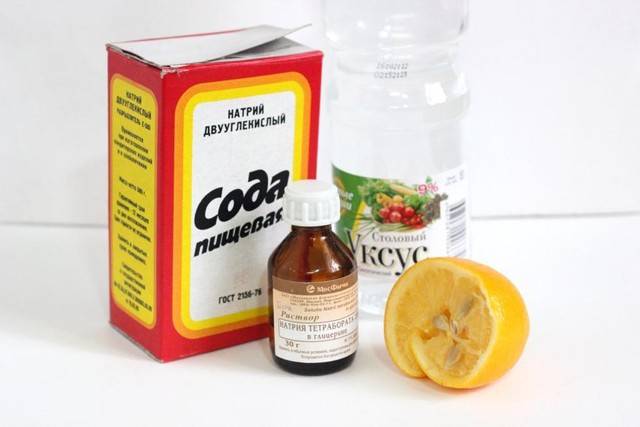
Onions, apples and lemons
Our grandmothers knew how to remove carbon deposits from the pan in a gentle way. The hostess always has an onion at hand. The onion needs to be cut in half, try to moisten with a cut and clean off the carbon deposits. Then chop the leftover onion and boil in a small amount of water in a dirty dish.
By analogy, you can also do with an apple. Wipe the burnt areas with a cut, pour the apple skins with water, adding citric (food) acid or lemon juice. The principle of action is an acidic environment formed by malic and citric acids, which eats away fat.
A potato cut in half also strips off small masses of fat.
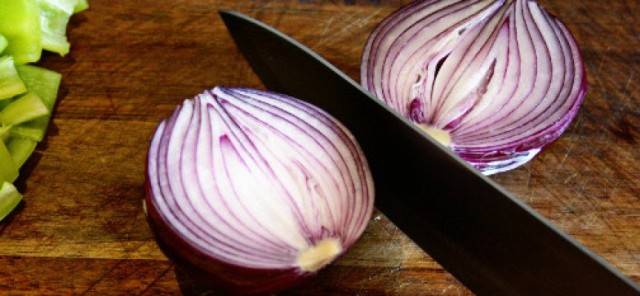
Fortune telling on coffee grounds
Sprinkle sleeping or ground coffee over the bottom of a burnt pan and leave for several hours. Make sure that the coffee does not dry out, add some water, so that there is gruel from the coffee all the time. Rinse off with water and a sponge.

Baking soda with glue and soap
Laundry soap, according to many housewives, is an excellent detergent, by its properties much superior to newfangled gels and shampoos for washing dishes. Rub a soap bar into coarse shavings, mix with baking soda (pack) and office glue (liquid glass). Add water and boil, stirring, to make a lump-free, homogeneous mixture. If you do this in a saucepan with a burnt bottom, it will be easily cleaned.
How do you clean the outside of the pot from carbon deposits? In this case, the container should be larger than the dirty saucepan.It should be completely immersed in the solution and continue to boil. Under the influence of detergents, the greasy layer, even an old one, softens and can be removed either with a washcloth or, in difficult cases, with a metal brush.
If it is not possible to boil the solution, then use it cold, the reaction time will lengthen, possibly up to a day.
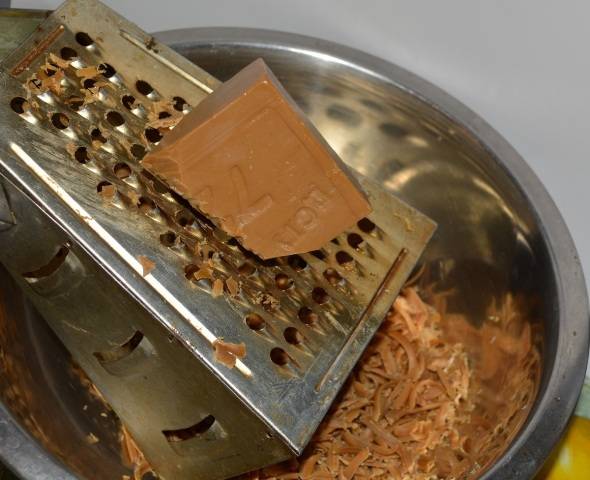
How to remove grease from a saucepan
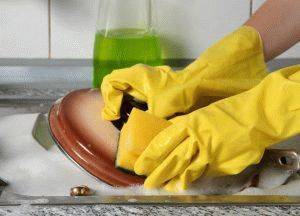
To avoid problems with old fat, it is recommended to soak the dishes immediately after use in warm water with the addition of detergent. Usually, such measures completely prevent troubles in the form of plaque and burning. However, if, for some reason, the fat still remains on the walls, then you should not immediately get upset and send the container to the trash can. There are effective ways to clean old fat from pots.
Folk ways
Perhaps in every home there are ingredients that can easily rid your pots of fat. But few people know that these seemingly simple tools can cope with such pollution so effectively.
Lemon acid
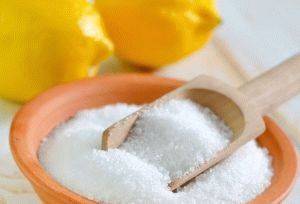
Citric acid fights well not only with scale, but also with fat. It breaks down any dirt and returns shine and cleanliness to the dishes. To wash off the fat from the pan, mix 30 grams of lemon and 30 grams of baking soda in a little water until a homogeneous gruel is formed. Apply the mixture to the walls and leave for 2-3 hours. After a while, you will notice that the fat has begun to break down and move away. Rinse off any remaining mixture with clean water and rinse the pan as usual. If it was not possible to achieve a positive result the first time, the procedure can be repeated by increasing the time the mixture is exposed to contamination.
Coca Cola
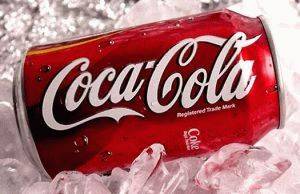
One of the weirdest uses of a sweet carbonated drink that still produces good results. Few people know that Coca-Cola is able to remove even rust, what can we say about fatty deposits? All you need is to fill the dirty container with a drink and leave it for 6-12 hours, depending on the intensity of the pollution. Next, rinse the pan in the usual way for you, and you will immediately notice that there is no trace of fat left.
Ammonia
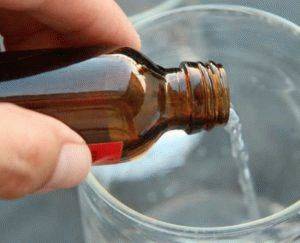
When using this method, it should be remembered that ammonia has a pungent chemical odor. For this reason, all cleaning work must be carried out in a respirator and with the windows as open as possible.
Laundry soap
Select a deep container so that the pan fits completely. Rub a piece of laundry soap there on a grater and dissolve the shavings in the water. The water should be very cloudy and soapy. Submerge a saucepan in the solution so that the water completely covers it and leave for 3-4 hours. Laundry soap sometimes dissolves fat better than special detergents, but acts a little slower. Then take out the pan and clean it with the back of the dish sponge. As a rule, after this method, the fat should be completely cleared.
Store funds
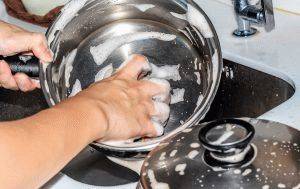
Special store products, which are aimed at removing fat, act faster and more efficiently than traditional methods. Their only drawback is the presence of aggressive substances in the composition that can harm the surface of the pan and even cause allergies. Therefore, when buying, be sure to read the instructions for use of the products. As a rule, different products are designed for different materials of manufacture. For example, what is suitable for cast iron is strictly forbidden to be applied to enamel or aluminum. Therefore, the first rule when choosing a store tool is that it should be designed specifically for the type of material from which your dirty dishes are made. Otherwise, you risk not achieving a good result and even ruining the pan. The most popular and effective universal means for removing fatty deposits are:
- AMWAY Oven Cleaner. One of the most effective remedies.In fact, it is designed for cleaning ovens from grease, however, it perfectly cleans other surfaces, including pots. When using, it should be remembered that the agent acts very aggressively, therefore, after use, the dishes must be rinsed with plenty of water.
- Bugs Shumanit. This product is also not designed for cleaning pots, however, it does an excellent job of removing stubborn and burnt fats. It can be used both for preparing a solution and as a detergent.
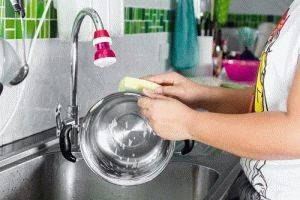
As you can see, removing old grease from the pan is not that difficult. The main thing is to choose the right cleanser. At the same time, depending on the degree of pollution, even folk methods can cope with plaque.
How to clean a cast iron skillet from perennial deposits?
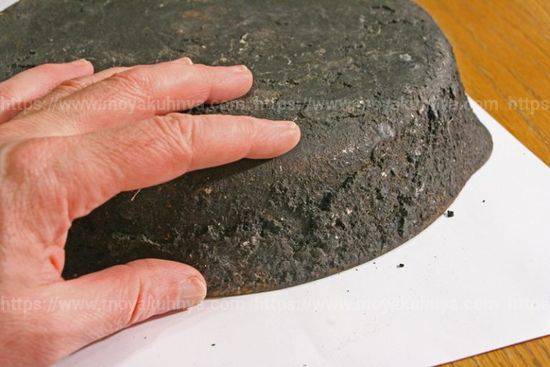
How to clean a cast iron pan? Over the years, it has become increasingly difficult to choose and buy such utensils. Old pans are of the highest quality and most durable. However, from fat and carbon deposits, they eventually deteriorate. These pans become dirty more quickly, requiring special care. How to clean a cast-iron frying pan from carbon deposits at home without spending much on special tools? There is always a way out, and your utensils will serve for many years to come.
How to clean the frying pan from grease and carbon deposits at home? You need to grate the soap on a regular coarse grater. Next, you need to take the boil and fill it with water, at least 5 liters. The boil diameter must be large for the pan to fit. After the water boils, pour the rubbed soap into it and pour in the glue. Mix everything well and boil for about fifteen minutes.
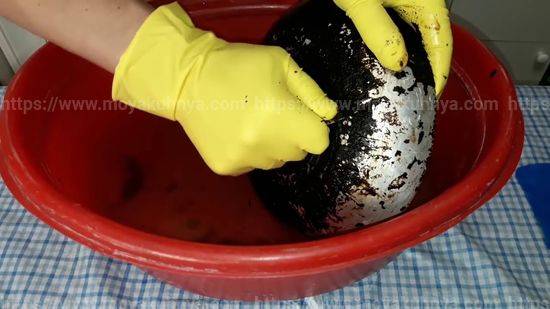
How to clean a cast iron frying pan from carbon deposits at home using this method?
- Dip the pan into the boiling mixture and cook it for 15-20 minutes. Water can evaporate, so keep track of the amount and add if necessary.
- Then replace the dirty water with clean, cold water. This will help cool the pan. The solution will make the dirt very soft, which makes it easy to peel the grease from the surface of the utensil.
- With an ordinary metal sponge or with a knife, we bring it to complete cleansing.
How to clean old carbon deposits from a frying pan? There is another cheap way without using purchased funds. You need to pour a couple of tablespoons of salt into the pan and pour vinegar over it. Now we put the utensils on the stove and wait for it to boil. After boiling, add a couple of tablespoons of regular soda. You need to cook until all the vinegar has evaporated. Then we rinse the pan well, soot and fat will easily go away.
So that you do not have to do this often, try to wash the utensils immediately after cooking. It is better to wash the dishes while they are still hot, so it will wash better.
Folk remedies for cleaning the pan from carbon deposits
Above, many recipes were considered on how to clean a pan from carbon deposits at home. If you group them by ingredients, you get a set of rules and recommendations for quick and high-quality cleaning of household utensils.
Salt and baking soda
In conjunction with baking soda, salt gains powerful cleansing abilities. A quick way to remove stubborn dirt from food that may have burnt is as follows:
- Mix baking soda and salt in equal parts;
- Cover the bottom of the cookware with the mixture;
- Add a few drops of water, mixing with the mixture until you get porridge;
- Leave closed for a day;
- Drain the porridge from the mixture and add the same composition, pour water over it and boil for half an hour;
- Drain the liquid, let the dishes cool down and rinse them with a sponge and dishwashing liquid.
Salt with baking soda has a cleansing ability.
Salt
Salt itself is not capable of removing strong dirt, but it can cope with the lungs, and will also allow for preventive cleaning of dishes:
- Pour fine salt into wet dishes and wipe the entire surface with it;
- Leave on for 3 hours;
- Wash off the saline solution with a hard sponge.
This advice on how to clean the pan from carbon deposits involves rubbing the surfaces of the dishes with salt, and this cannot be done with enameled objects.
Table salt helps with light stains.
Activated carbon
Charcoal is the easiest way to get rid of burnt milk or other food:
- Crush several tablets into powder;
- Cover the bottom of the dish with charcoal and leave for 30 minutes;
- Pour in warm water and leave for another hour;
- Remove carbon residues with a sponge.
Activated charcoal helps to deal with burnt milk.
Soap solution
In the case of light, fresh dirt, you can use the following recipe:
- Fill the dishes with water and add liquid soap or gel there;
- Cook the composition for half an hour;
- Pour out the contents, cool the dishes and wash them in the usual way.
Milk whey will help clean heavily soaked dishes.
Milk serum
If the dishes have heavily soaked areas, the acids in the whey will help clean the pan. You just need to fill the dishes with serum, leave for 24 hours, and then wash in the usual way.
Features of washing dishes from various materials
Glass
It is better to wash glassware in hot water with soft sponges, without using products with small particles: pastes, powders.
To make glass products shine, they need to be washed with the addition of vinegar. This requires:
- Make a solution of acid in water at the rate of: 1 tbsp. l. active substance per 1 liter.
- Pour the resulting liquid into a large container.
- Immerse the dishes in the solution so that it covers it completely.
- Leave on for 15 minutes.
- Wash in the usual way, dry.
Porcelain
Do not clean porcelain with hard brushes or abrasives. You can use a soft bristled toothbrush to clean hard-to-reach areas. The water should be at room temperature.
Crystal
It is best to wash crystal dishes with baking soda, it will remove plaque from the products. Tall glasses and embossed surfaces can be easily washed with a toothbrush or a small household brush - the soft nap will clean out dirt even from the most difficult to reach places.
Plastic
Plastic is a rather finicky material. Therefore, it can only be washed with gel and a soft sponge. Hard washcloths, abrasive, aggressive household chemicals, soda must not be used, otherwise the plastic will be covered with unsightly scratches. Products made from this material are also not dishwasher safe.
To clean plastic utensils, you can make a vinegar solution. This requires:
- Mix vinegar and water in a 1: 4 ratio. You can add 1-2 drops of dishwashing liquid for best results.
- Wipe the plastic with the resulting mixture.
- Soak the container for 50-60 minutes.
- Wash it with your usual product.
Aluminum
Aluminum is a picky material, but it is not recommended to anneal it - it may not withstand high temperatures. Also, do not wash aluminum dishes with abrasive substances, metal sponges and in the dishwasher.
Aluminum can be cleaned with baking soda or mustard powder. To do this, gently rub the pan or pan with the selected product, leave for 20-25 minutes, then wash off the remaining dirt.
Stainless steel
You need to wash the stainless steel in water at room temperature, without abrasive substances, hard tools.
Lemon juice can be used for stainless dishes. Necessary:
- 2 tbsp. l. dilute juice with 500 ml of water, mix well.
- In the resulting solution, moisten a sponge, wipe the stainless steel with it.
- Wash with warm water.
- Wipe dry.
Cast iron
Cast iron dishes can be washed with aggressive chemicals, hard brushes, sponges, as this is the most picky and durable alloy. It is also allowed to ignite cast iron, for example, to clean the pan of carbon deposits.
Cleaning with special agents
With the help of chemical cleaners, you can deal with carbon deposits on all types of baking sheets, including non-stick ones.The main thing is that the composition of the product does not contain caustic alkalis and acids. To reduce the degree of negative impact, use the instructions.
- Use paper towels to remove grease and food debris.
- Apply liquid, gel or powder to the surface and wait 20 minutes.
- If there are dried food particles, soak the baking sheet in warm water.
- Wipe the surface. Aluminum and stainless steel sponge, and non-stick and ceramic soft sponge.
- Rinse liberally with clean water and wipe dry.
Is it difficult to clean a heavily soiled baking sheet?
Not really
Using household chemicals, you can wash the baking sheet even from old fat.
General cleaning tips
Let's consider some recommendations to help housewives keep the dishes clean:
- After each frying of food, it is better to wash the pan right away, especially the pancake pan. This will help keep the dishes in good condition for longer.
- When washing off carbon deposits, do not put a hot pan under cold water. Temperature extremes can damage the finish.
- You can wash the enamel pan without any problems with bleach.
- Stainless steel dishes are easy to clean with salt or soda.
- It is better not to wash the glass lid with powder detergents. After a while, small scratches will become noticeable.
- The grill pan cannot be washed in the dishwasher, and it is also better to rid it of the metal sponges.
- Boiling water with vinegar in a pan will help get rid of rust.
- After washing, let the pan dry well; do not put wet dishes in the kitchen cabinet. Keep the pan lids removed.
- Heavily smoked pans can be handed over to a professional for cleaning. This is especially true for expensive dishes that you would not want to spoil.
Folk cleaning methods
Not all types of kitchen utensils can withstand cleaning with household chemicals. For example, ceramic or products with a special coating must never be cleaned with chemicals. They corrode the coating and the dishes become unusable.
Folk dish cleaning products are much more gentle and can be applied to any kitchen utensil.
Laundry soap
One of the best products for cleaning pans and pots from the inside of pans is laundry soap. To prepare the solution, you will need 72% laundry soap and clean water.
The steps for cleaning with soap are as follows:
- Half of the soap bar is rubbed on a coarse grater.
- The shavings are poured into the container that needs to be cleaned and filled with water. It should not reach the edge by about 5 cm. Turn on the heating underneath.
- After the solution boils, the heat must be reduced, and a slight boil must be maintained for the next half hour.
- Then the stove is turned off, the container is covered with a lid and left to cool completely.
- Then the solution is drained, and the pan or pan is cleaned with a sponge.
This cleaning method does not damage the coating, so it can be used for both ceramic and Teflon dishes.
Vinegar and citric acid
Vinegar combined with citric acid gives excellent results. The cleaning composition is prepared as follows:
- A small saucepan is required to prepare the solution. A liter of water is poured into it and brought to a boil.
- Then half a glass of 9% vinegar and a tablespoon of citric acid are dissolved in hot water.
- In a hot solution, soak contaminated dishes for 1 hour.
After this procedure, even old fat can be easily cleaned off with a metal or nylon washcloth.
Rules for cleaning pans depending on the material and tips for prevention
Different types of metals and coatings react differently to acids and alkalis, prolonged soaking and heating. When starting to wash your frying pan, find out the contraindications (if you look at the table on your smartphone, turn it to a horizontal position - so the entire table will enter the screen).
| Cast iron cookware | Teflon cookware | Stainless steel | Aluminum cookware without non-stick coating and enamel | |
|---|---|---|---|---|
| Dishwasher safe | Not allowed (the pan will be covered with rust) | Can | Can | It is forbidden |
| Using abrasive cleaners, brushes, scrapers and hard sponges | Can | It is forbidden | Can | It is forbidden |
| Using baking soda, laundry soap, and other alkaline cleaners | Can | Can | Can | It is forbidden |
| The use of acids (vinegar, citric acid, etc.) | Can | Not allowed (short-term exposure is acceptable) | Can | Not allowed (short-term exposure is acceptable) |
| Prolonged soaking | It is forbidden | Can | Can | Undesirable |
- Aluminum pans (uncoated) can be washed with detergents for glass and porcelain dishes, soap solutions with the addition of ammonia.
- Any dishes should be washed only after they have cooled naturally. If you suddenly transfer a hot pan to cool water, it may deform. This is especially true for cast iron, aluminum (coated and uncoated) and ceramic pans.
- Remember to remove the wooden / plastic handle before soaking or boiling the pan, or simply don't submerge it in water.
Delicate way
If there is no serious contamination, in order to protect the dishes, it is best to give preference to this gentle method. You will need to stock up on a soft sponge, cleaning agent, warm water
Wash the baking sheet carefully without pressing on it. This option is suitable for Teflon, ceramic products - during such cleaning, the surface is not scratched
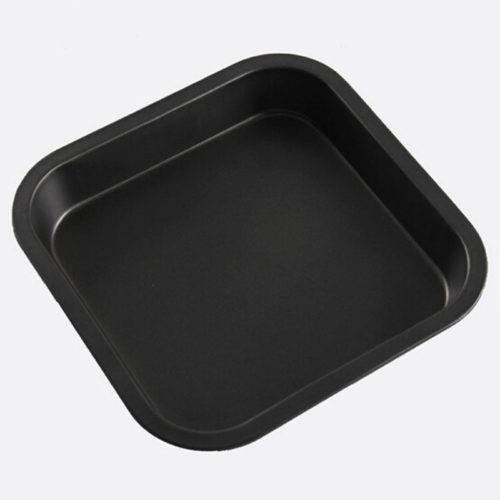
It is best to give preference to a gel. If the dishes are made of silicone, they will be convenient to use - the food will not burn, and it will be easy to clean the baking sheet. Use a mild detergent to clean it.
If the contamination on the Teflon baking sheet is difficult, cleaning will not be done in one step. Before cleaning a baking sheet made of such material from carbon deposits, it is necessary to scrape off the remnants of food from the surface, and then sprinkle the dishes with salt. It must be left for 10 minutes for the best effect of the substance. During this time, the salt will absorb the fat. They wash it off very carefully: the substance can leave scratches on the surface.
After moistening a soft sponge in hot water, you will need to drip gel here, and then wash the dishes. To avoid this cleaning in several steps, it is best to follow the rules for using Teflon cookware.
Means for silicone and teflon trays
Molds and sheets made of silicone and Teflon were invented to facilitate the cooking process, because if technology is followed, practically nothing sticks to high-quality dishes. However, over time, a layer of carbon is still formed, and it can only be removed in gentle ways:
- Soak a silicone or teflon mold in warm water and a gel dishwashing liquid. After 30-60 minutes, rinse with clean water and a soft cloth or sponge.
- Clean the Teflon baking sheet from food debris and cover the bottom with fine salt. After half an hour, remove the dirty salt and rinse with hot water. If carbon remains on the dishes, soak the dish in hot water and liquid detergent.
After washing, be sure to wipe the surface of the sheet or mold with a paper or cloth towel dry to remove all drops in which microparticles of fat may remain.
How do I clean the pan depending on the material and coating?
Cast iron

Such material requires a very reverent attitude, because it is very fragile and easily deformed. The following methods will help to create the effect of “novelty”:

method one. Sprinkle salt on the bottom so that the bottom dirty from soot is not visible. Next, pour one hundred and fifty grams of nine percent vinegar into the bowl and leave the frying pan alone for half an hour. The next step is to add one hundred grams of baking soda and boil for fifteen minutes on the stove. All dirt can be removed with a brush, and the surface from a greasy shine can be rinsed with water;

method two. Place a skillet in a container and fill it with water.Next, rub the soap and put two hundred grams of glue and five hundred grams of soda ash in the liquid. Put on fire and heat to a boil, and then simmer, waiting for the soot to peel off;
method three. Remove the handle from the pan and place in the oven. Increase the heat in the oven to two hundred and fifty degrees. Be sure to open the window during processing.

Aluminum

Aluminum frying pans do not crush strong powder compositions for cleaning; it is better to use sprays or gels. It is advisable to clean the dishes after each cooking, because carbon deposits very quickly appear on the aluminum. Below are a few ways to clean up:

- the first recipe. Dissolve three hundred grams of salt in water and boil a frying pan in it for two hours;
- second recipe. Fill the pan completely with sand and ignite for two hours or more.
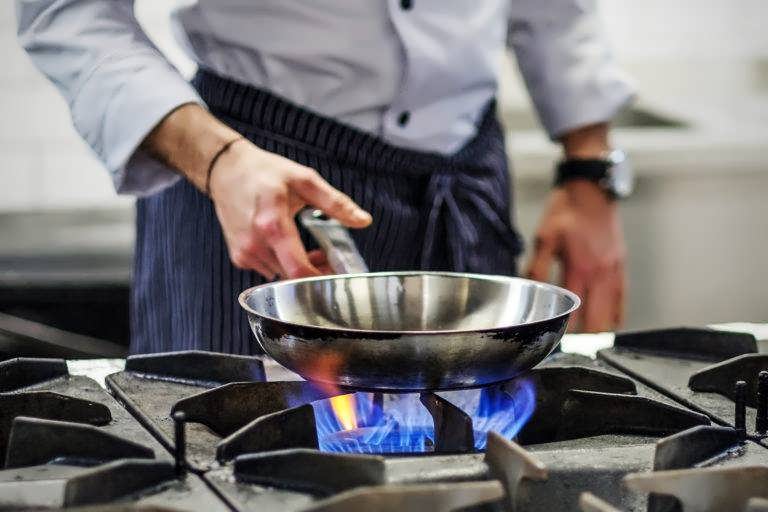
Teflon

Cleaning a Teflon frying pan is very tricky as the coating of the cookware is very easy to ruin, but people have come up with a great cleaning method. Pour water into a skillet, place on a heated comfort and bring the water to a boil. Next, turn off the heat and add two tablespoons of soda ash and a little dishwashing liquid.

After an hour, the plaque should become softer and after it can be washed off with a soft sponge. If possible, boil the pan with clean water one more time.
Ceramic coated
This coating on pans allows you to cook great pancakes and scrambled eggs on them, so keeping them clean is very important for the taste of food. There are several proven ways:

- method one. Carbon deposits come off the walls and bottom almost instantly if you wipe the utensils with a cotton pad soaked in alcohol;
- method two. If burned in a skillet from food, then fill with water and boil for fifteen to thirty minutes. If the carbon does not go away, add a little citric acid.
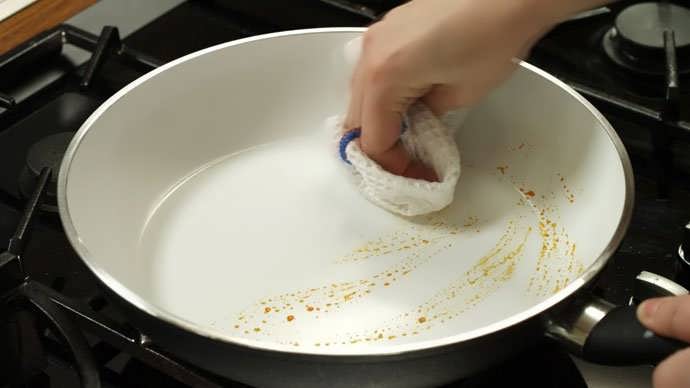
How to dry properly
If you have a clean container in your hands, the next problem arises - how to dry it. In practice, it turns out that the use of a hair dryer is unsuccessful.
Glass bottle
The method will require any kind of paper, but it is desirable that it perfectly absorbs moisture. Even tea towels will work. A piece of paper is rolled up and placed inside. It is advisable that the end sticks out of the container, as it is needed in order to get the paper.
Plastic
The container is turned upside down and placed on the surface. It is desirable to substitute something under the neck. Air should enter inside, which will speed up drying.
Household chemicals
Now there are a variety of professional household chemicals, with which it is very easy to clean pans, because it breaks down old fat more efficiently and quickly than traditional methods. You can clean carbon deposits with the following means:
- Cilit Bang Anti-Fat. This substance degreases and is suitable for both fresh and very old carbon deposits. The plus is that Cilit Bang can be found in any hypermarket.
- Gold Unicum removes carbon deposits from dishes without damaging the surface.
- Shumanite. This remedy can be found in almost all stores and supermarkets. It is not cheap, has a pungent smell, is difficult to wash off, but copes well with very old fat.
- Mister Muscle. Another affordable, fairly budgetary substance that copes with many types of pollution, including carbon deposits.
- Helper Professional. This product is suitable for any coating, even non-stick. It promotes gentle cleaning without scratching the surface with abrasives.
This cleaner is quite difficult to find, but it copes with its task perfectly: it is practically odorless, removes even the most stubborn carbon deposits, and is easily removed from the surface.
Pipe cleaner can also be used against old carbon deposits and grease. It acts more aggressively, so you should not test its effect on Teflon and ceramics.
Process steps
Observance of some rules, as well as an algorithm of actions, will help to wash the dishes quickly.
Sorting
The first step in the washing process is sorting. The need for it is explained by the fact that cutlery, pots, plates, cups have different degrees of contamination. Correctly wash the dishes in the following sequence:
- Glasses, mugs, wine glasses, glasses, as they do not come into contact with fat or foods with a persistent odor. Soaking in this case is not only possible, but even necessary to skip: the glasses will only become dirtier after lying in the water along with greasy pans and plates.
- Spoons, forks and knives. They also do not require soaking, it is enough to wash them with detergent.
- Plates, salad bowls, cutting boards. The latter should be additionally wiped with vinegar if fish or meat were cut on them. This will disinfect the surface.
- Pots, pans, cauldrons, ladles, baking dishes. They definitely need soaking, otherwise it will be very difficult to clean the fat and carbon deposits.
Soak
To quickly wash the dishes with your hands, you should first soak them. So the adhering dirt will soften, it will become much easier to wash them.
Remove large food particles before soaking. Then place the dishes in a large container with hot or very warm water - this can be a basin, a bucket. It is also possible to use the sink after plugging the drain. It is better to add a couple of drops of detergent to the water - this will make the soaking more effective. After 20-30 minutes, drain the water and proceed to the main procedure.
The washing up
After sorting the dishes and soaking the necessary items, you can proceed directly to washing.
The algorithm is as follows:
- Apply 1-2 drops of detergent to a sponge.
- Squeeze the product in your hands several times so that foam appears.
- Wash the plate, cutlery or pot on all sides, carefully scrubbing off any food debris.
- If necessary, use a metal sponge or hard brush to remove tough dirt.
- Rinse the product thoroughly under a stream of warm water, preferably several times. If the water is cold, the fat will wash out worse.
Drying
After washing, you can immediately send the dishes to the dryer, where excess moisture will drain from it. It is not necessary to wipe the appliances with a towel or dry cloth. Moreover, scientists have proven that a towel is a favorable breeding ground for bacteria, some of which can cause poisoning if they get on plates or cups.
But glasses, mugs, wine glasses, jugs should still be wiped off, since water stains remain on them, which spoil the beautiful view. Therefore, the best solution would be to wipe only transparent products. And so that bacteria do not grow on the towel, you need to dry it and change it every 7 days.


